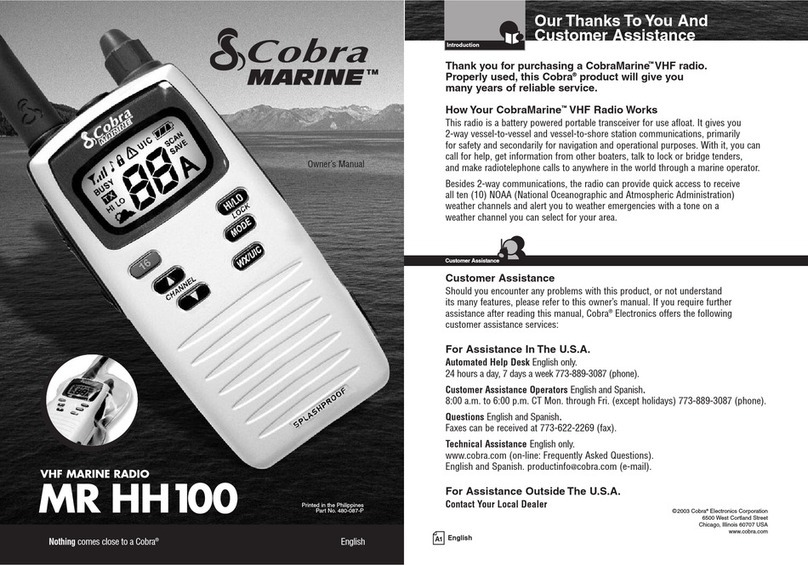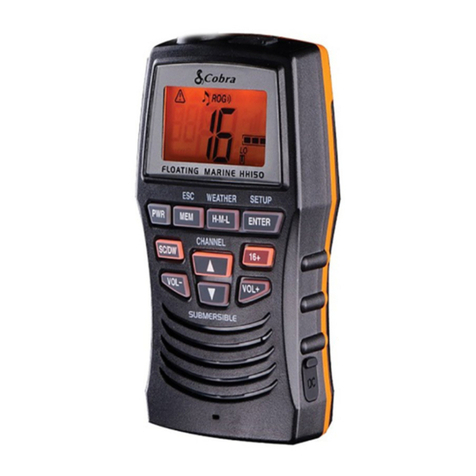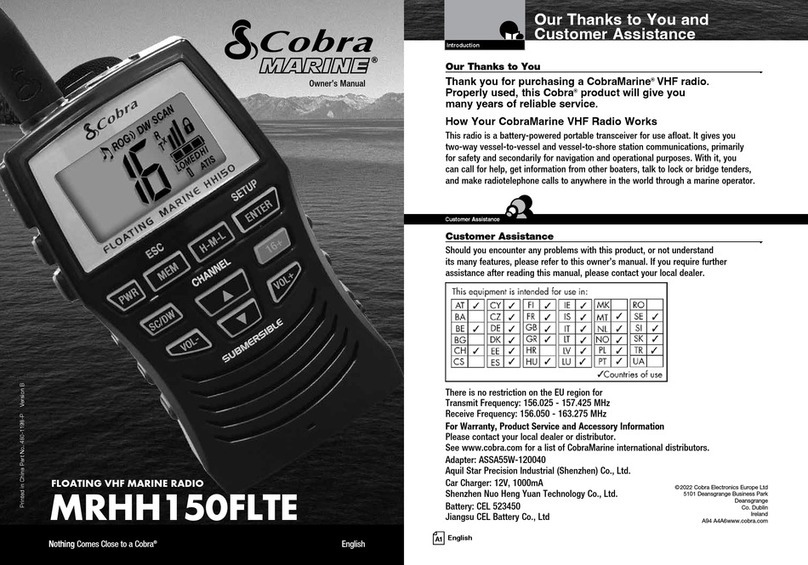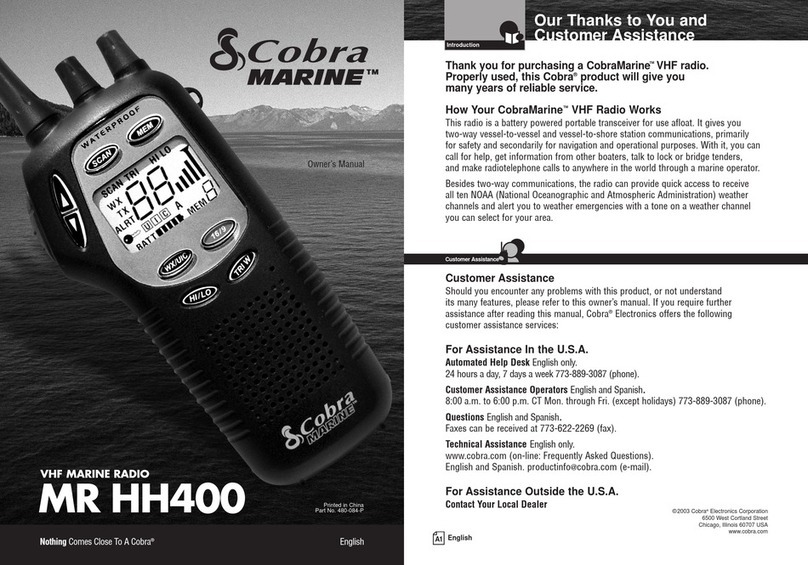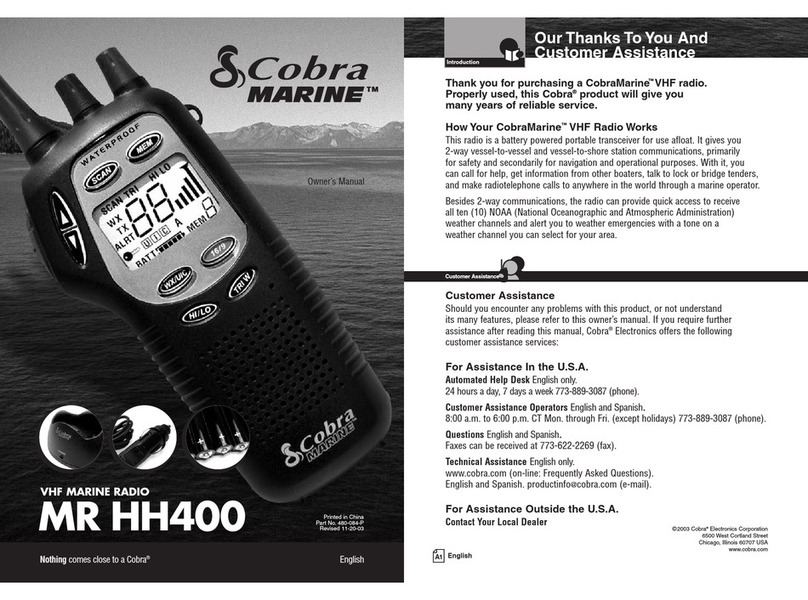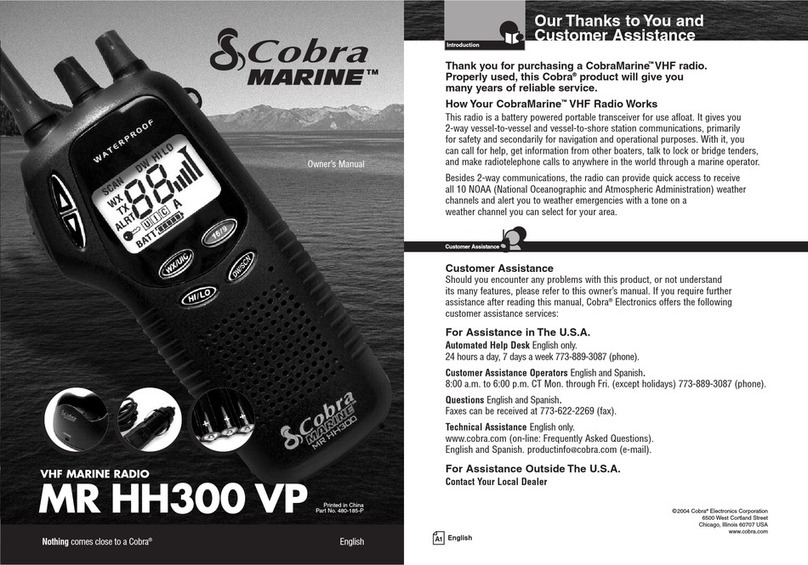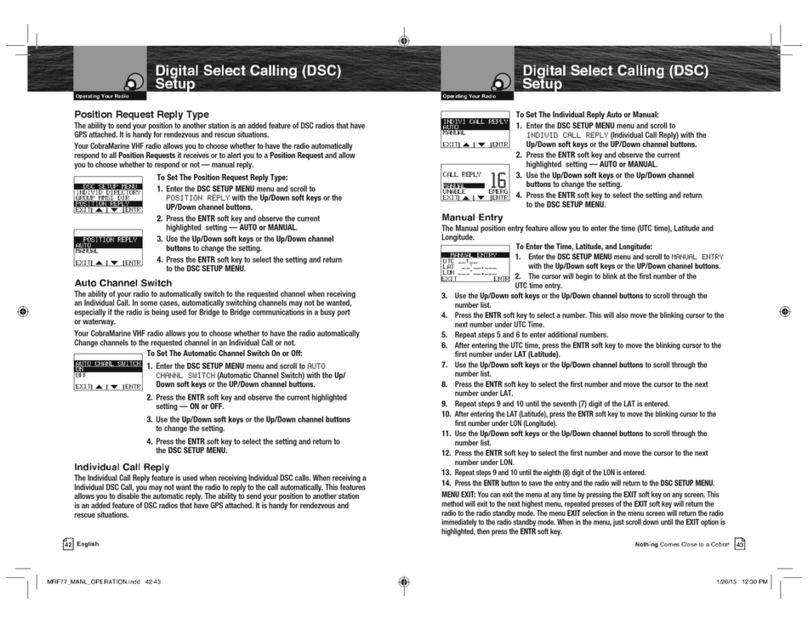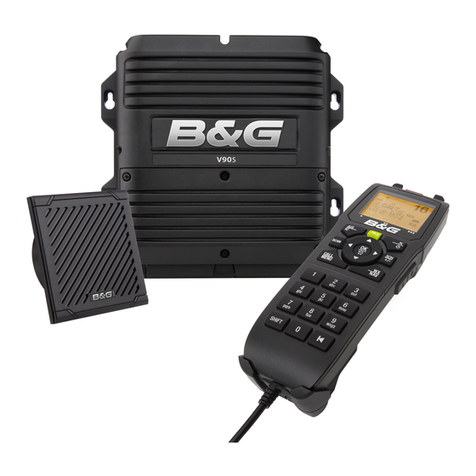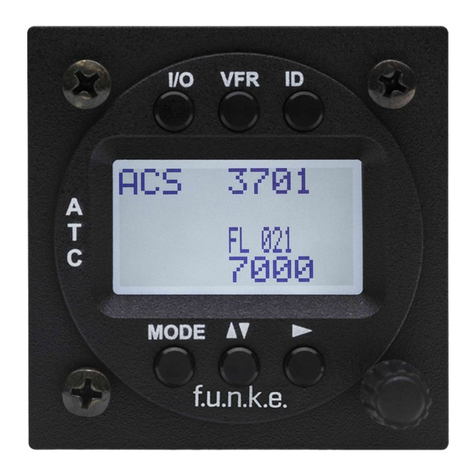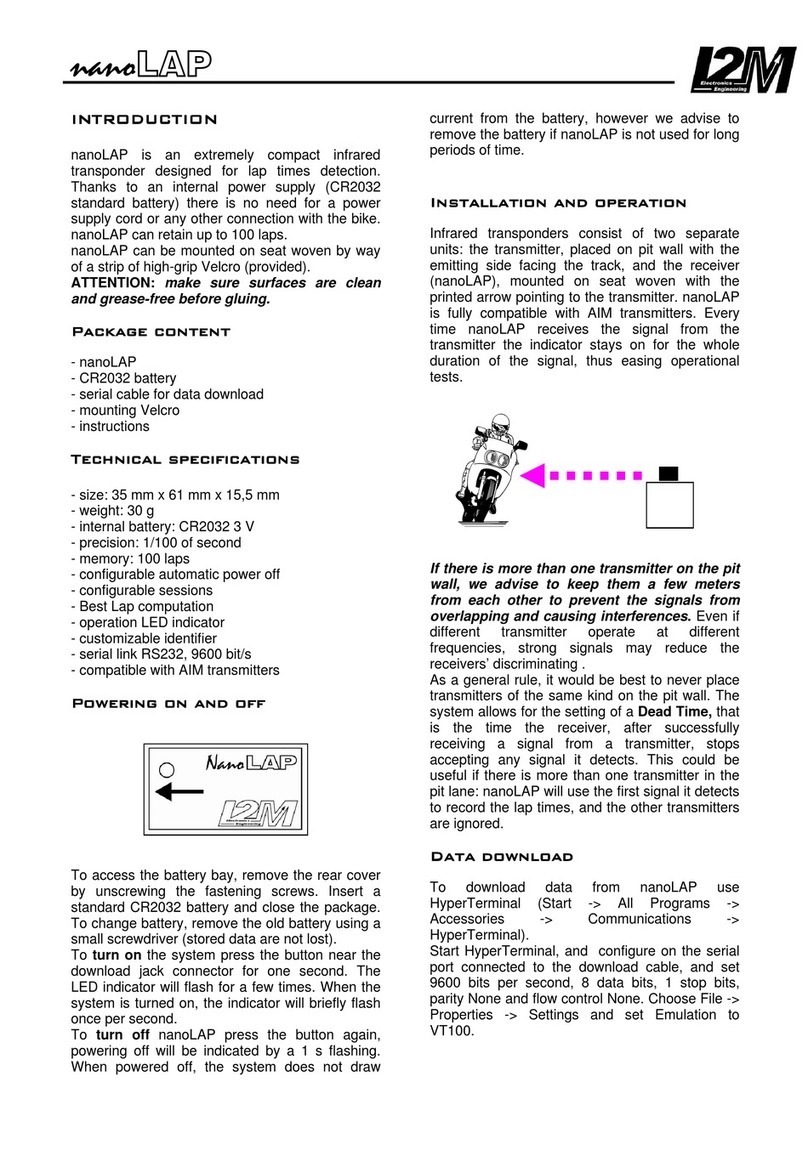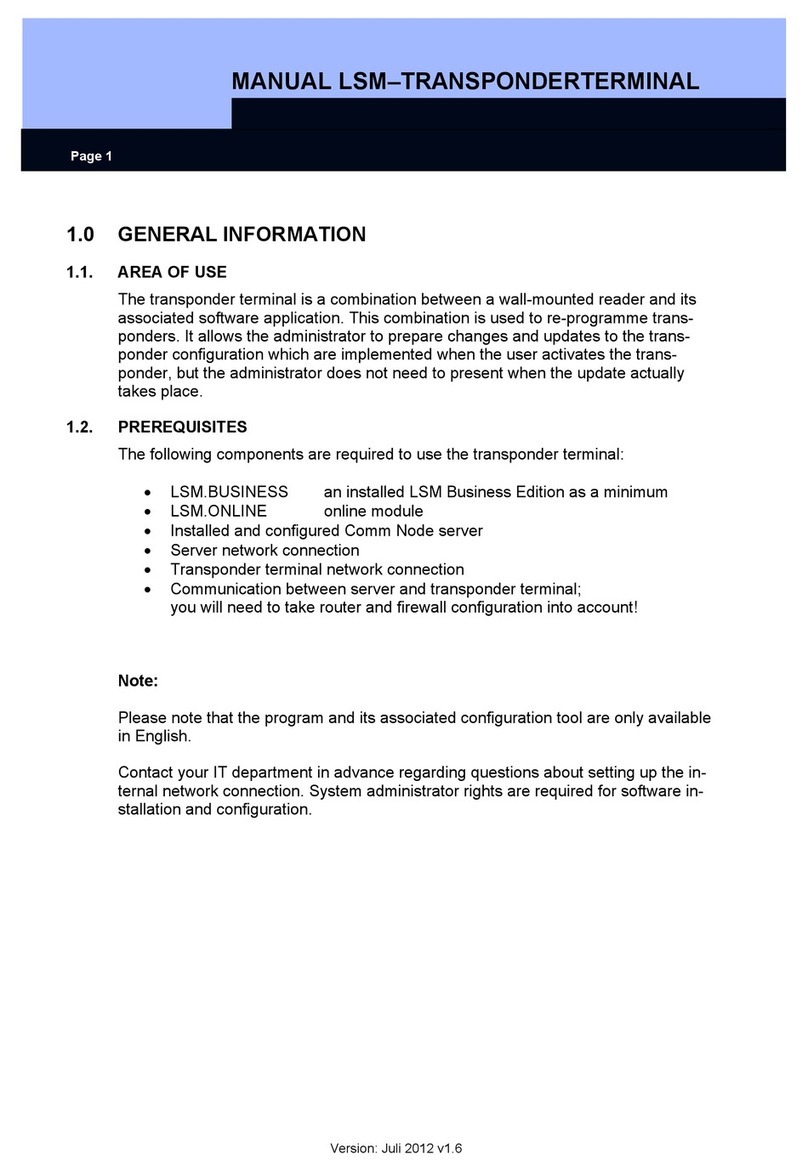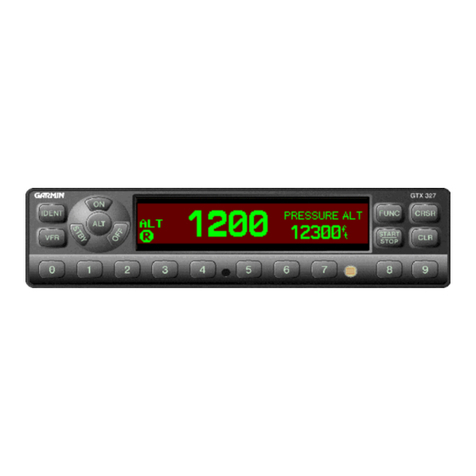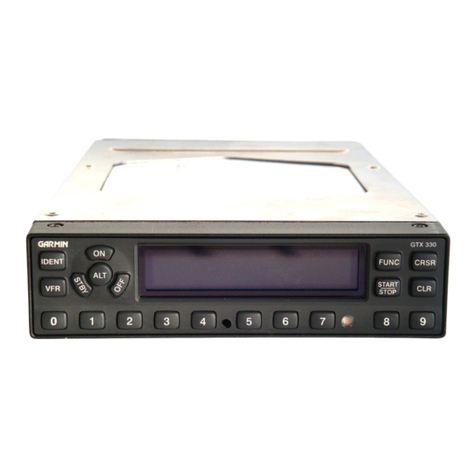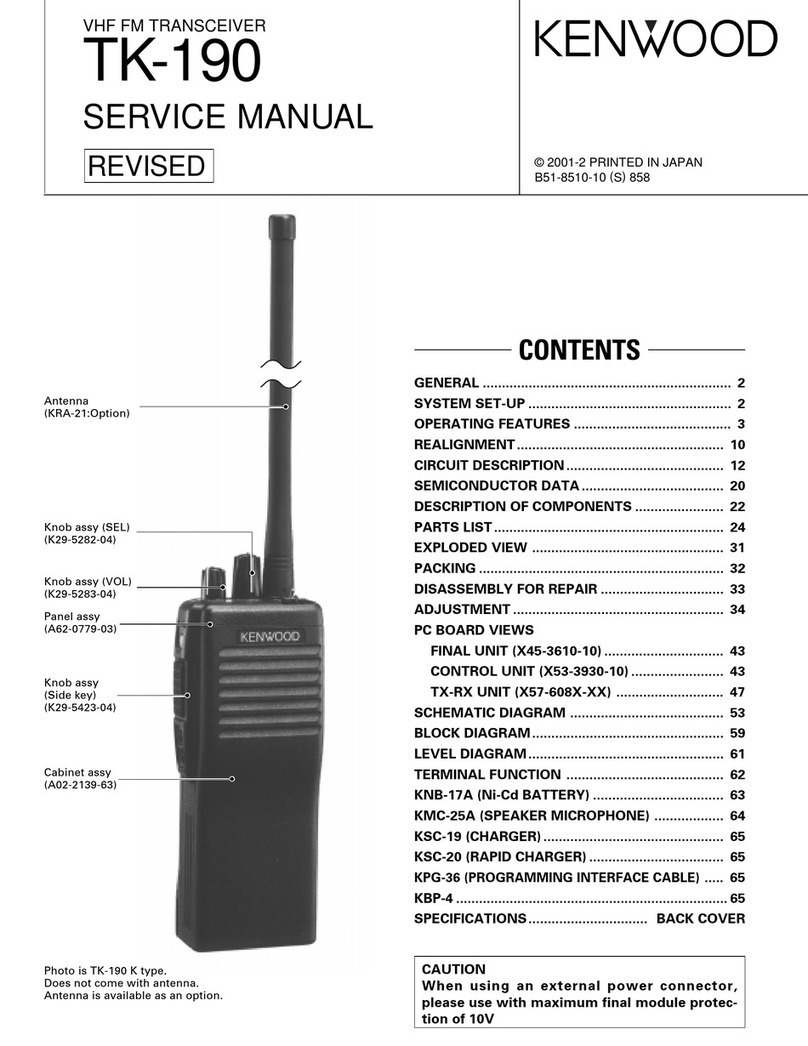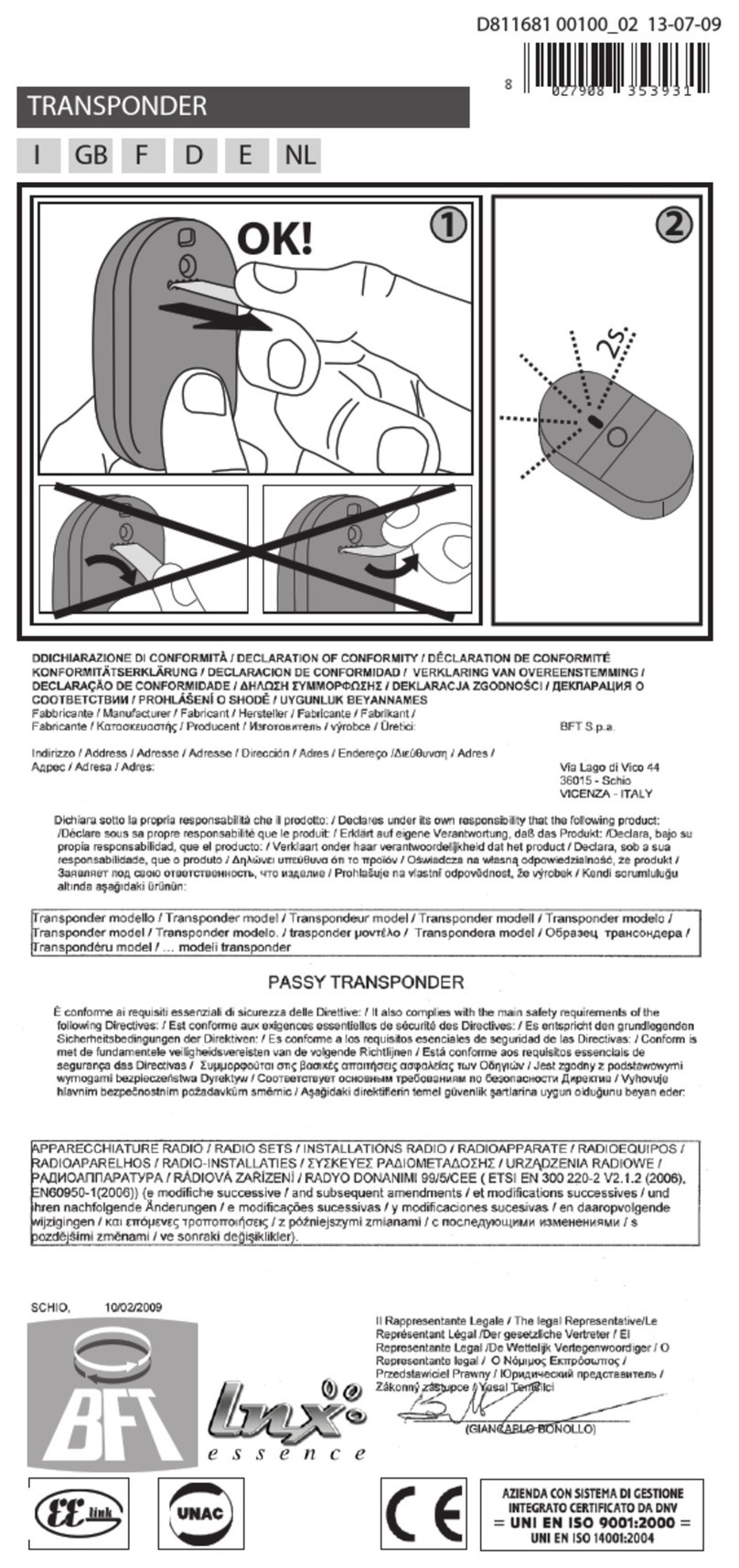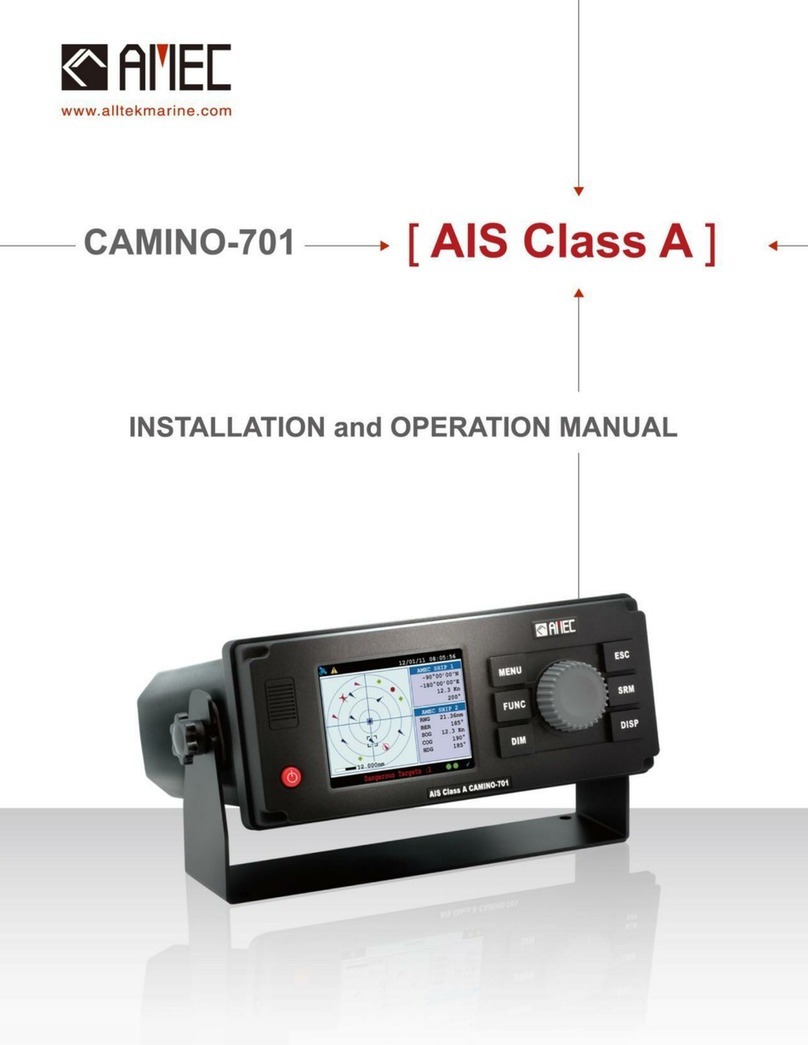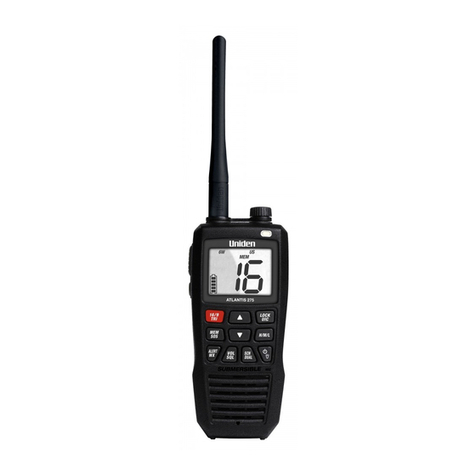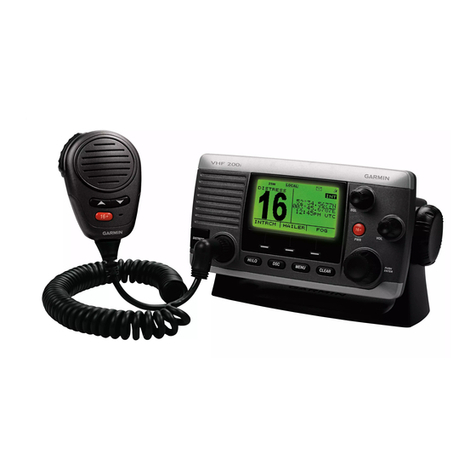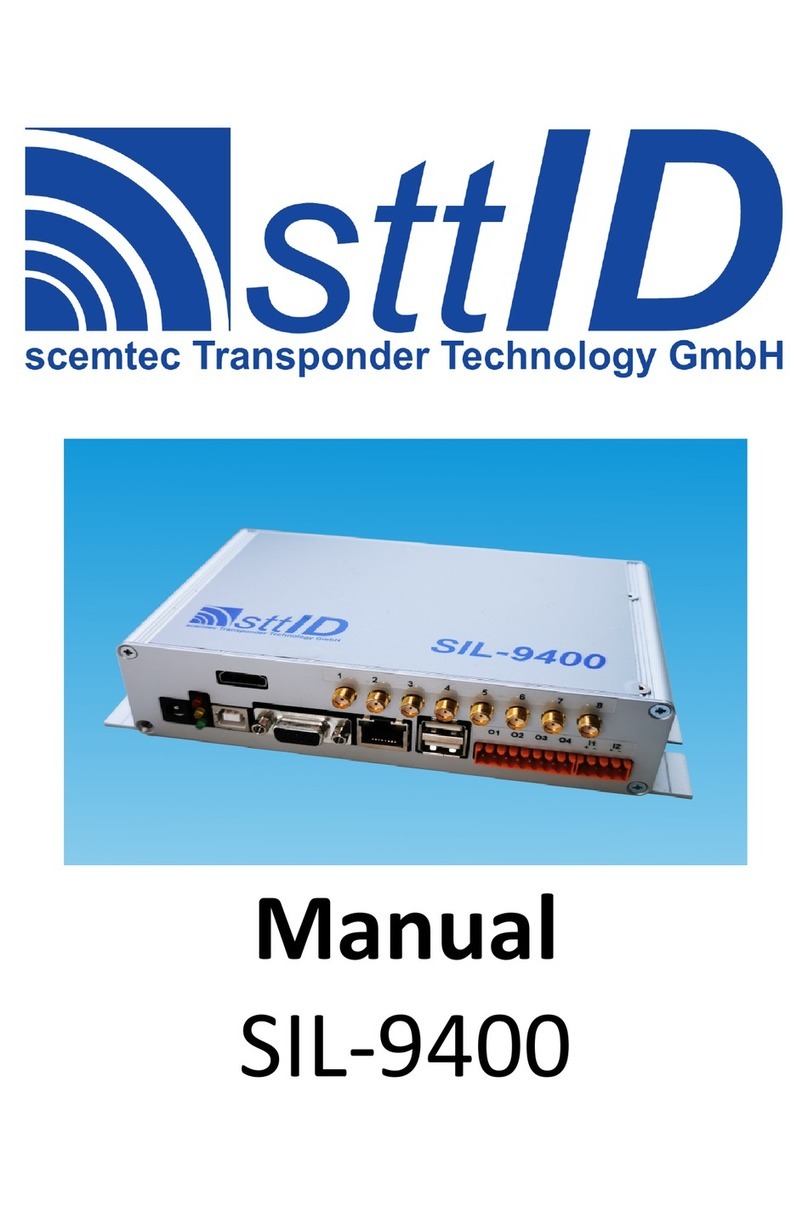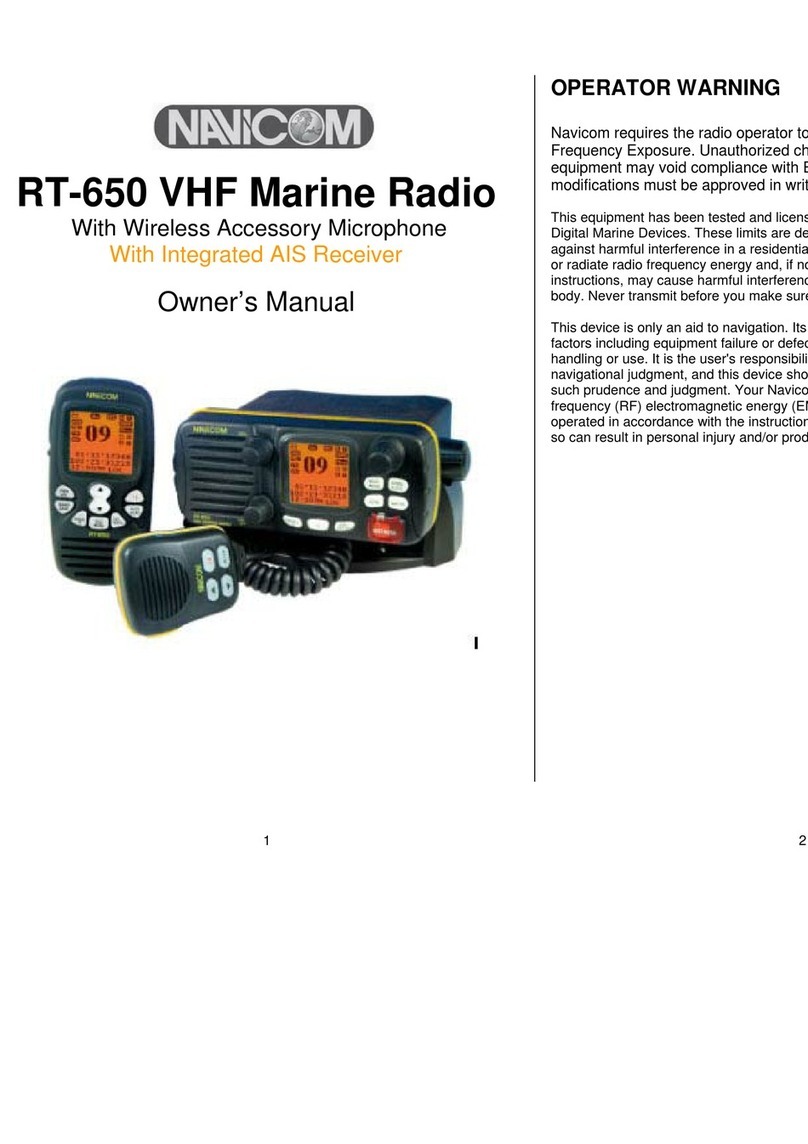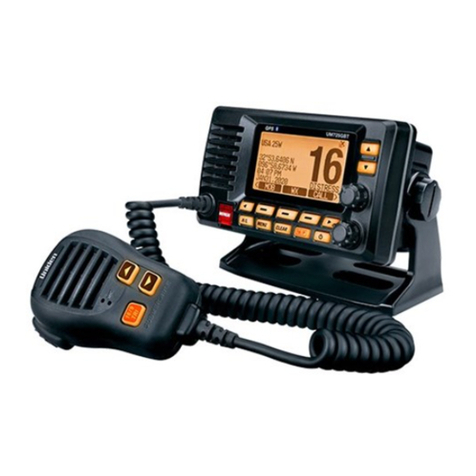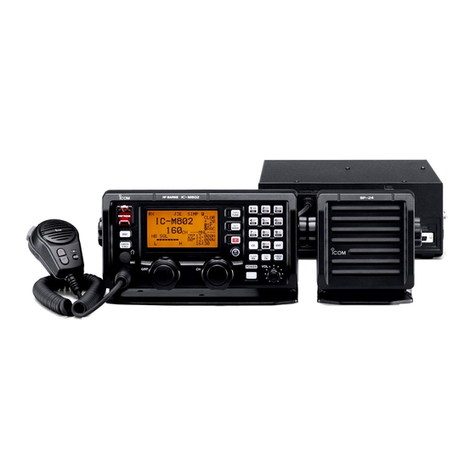Cobra Marine MR F75 EU User manual

A1 English
Our Thanks to You and
Customer Assistance
Intro Operation Customer
Assistance
Warranty
Notice
Secondary Icons
Caution Warning
Installation Customer
Assistance
Introduction
Thank you for purchasing a CobraMarine™VHF radio.
Properly used, this product will give you many years
of reliable service.
How Your CobraMarine™VHF Radio Works
This radio is a VHF transceiver for fixed mounting on your boat. It gives you 2-way
vessel-to-vessel and vessel-to-shore station communications, primarily for safety
and secondarily for navigation and operational purposes. With it, you can call for
help, get information from other boaters, talk to lock or bridge tenders and make
radiotelephone calls to anywhere in the world through a marine operator.
Customer Assistance
Should you encounter any problems with this product, or not understand
its many features, please refer to this owner’s manual. If you require further
assistance after reading this manual, please contact your local dealer.
NOTE
Your equipment will be black. White images are shown in this manual for
illustration purposes only.
This equipment is intended for use in:
For Warranty, Product Service and
Accessory Information
Please contact your local dealer or distributor.
See the enclosed leaflet that provides contact
information for the CobraMarine™international
distributors.
Intro Operation Customer
Assistance
Warranty
Notice
Main Icons
Secondary Icons
Caution Warning
Installation Customer
Assistance
Customer Assistance
©2004 CobraElectronics Europe Limited
Dungar House
Northumberland Avenue
Dun Laoghaire
County Dublin, Ireland
www.cobra.com
Intro Operation Customer
Assistance
Warranty
Notice
Main Icons
Secondary Icons
Caution Warning
Installation Customer
Assistance
❑
aAT
❑
aBE
❑CY
❑
aCZ
❑DE
❑
aDK
❑
aEE
❑
aES
❑
aFI
❑
aFR
❑
aGB
❑
aGR
❑
aHU
❑
aIE
❑
aIS
❑
aIT
❑
aLT
❑
aLV
❑
aLI
❑
aLU
❑
aMT
❑
aNL
❑
aNO
❑
aPL
❑
aPT
❑
aSE
❑
aCH
❑SI
❑
aSK
❑TR
VHF MARINE RADIO
MR F75 EU
Printed in China Part No.480-121-P
Owner’s Manual
Nothing comes close to a Cobra®English
For more information or to
order any of our products,
please visit our website:
www.cobra.com
CB Radios
microTALK®Radios
Radar/Laser Detectors
Safety Alert®Traffic Warning Systems
Handheld GPS Receivers
Mobile GPS Navigation Systems
HighGear®Accessories
CobraMarine™VHF Radios
Power Inverters
Accessories
The Cobra Electronics Corporation™
line of quality products includes:
Nothing comes close to a Cobra®English

A3 English
Microphone/Speaker
and Product Features
Intro Operation Customer
Assistance
Warranty
Notice
Secondary Icons
Caution Warning
Installation Customer
Assistance
Introduction
Dual Power
Selectable to 1 or 25 watts output
power for near or distant calling.
International/Canada/U.S.A. Channels
Allows operation on any of the three
different channel maps established
for these areas.
Instant Channel 16
Instant access to the priority
Channel 16.
Digital Selective Calling (Class D DSC)
Allows sending a distress message
at the touch of a button as well as
specific station-to-station calls.
Memory Scan
Lets you scan through all selected
memory channels to find conversations
in progress.
Tri-Watch
Lets you monitor three channels at
once — Channel 16 and two user
selectable channels.
Noise Canceling Microphone/Speaker
Blocks background noise to let your
voice be heard at the receiving station.
Controls on the Microphone/Speaker
Handy control buttons on the microphone/
speaker let you operate single-handed at
adistance from the radio.
Illuminated Buttons
Helps you quickly find the buttons
you need in low light conditions.
Complete Mounting Kits Included
Radio can be mounted on, under
or in almost any flat surface using
one of the included brackets.
Waterproof
Submersible to 1 metre of water
for 30 minutes — meets JIS7 Standards.
Product Features •
Microphone/Speaker with Auxiliary Controls •
Up
Button
Microphone/
Speaker
Volume Up
Button
Down
Button
Talk
Button
Volume
Down
Button
Instant
Channel
16 Button
Up/Down Buttons
Can be used instead of
those on the transceiver.
Instant Channel 16 Button
Can be used instead of
the one on the transceiver.
Volume Up/Down Button
Can be used instead of
the On-Off Power/Volume
knob on the transceiver.
A2 English
Transceiver Controls,
Indicators and Connections
Intro Operation Customer
Assistance
Warranty
Notice
Secondary Icons
Caution Warning
Installation Customer
Assistance
Introduction
On-Off
Power/
Volume
Knob
Up
Button
Backlit LCD
Screen
Memory Scan/
Memory Clear
Button
Down
Button
Active
Channel
Number
Radio Status and
Data Display
UIC
Button
Instant
Channel 16
Button
Squelch
Knob
Microphone/
Speaker Cord
Connection Socket
Position Coordinates —
Latitude and Longitude
High/Low
Power Button
Call/Set
Button
DSC Distress Button
(Behind Red Cover)
Tri-Watch
Button
Simplex
Operation
Icon
Power
Connection
External Speaker
and PAJack
Antenna
Socket Global Positioning
System (GPS) Jack

Intro Operation Customer
Assistance
Warranty
Notice
Secondary Icons
Caution Warning
Installation Customer
Assistance
Introduction
Nothing comes close to a Cobra®
Table of Contents
1
Intro Operation Customer
Assistance
Warranty
Notice
Main Icons
Secondary Icons
Caution Warning
Installation Customer
Assistance
Intro Operation Customer
Assistance
Warranty
Notice
Icons
ndary Icons
Caution Warning
Installation Customer
Assistance
Intro Operation Customer
Assistance
Warranty
Notice
Icons
ndary Icons
Caution Warning
Installation Customer
Assistance
Intro Operation Customer
Assistance
Warranty
Notice
Icons
ndary Icons
Caution Warning
Installation Customer
Assistance
Introduction
Our Thanks to You . . . . . . . . . . . . . . . . . . . . . . . . . . . . . . . . . . . . . . . A1
Customer Assistance . . . . . . . . . . . . . . . . . . . . . . . . . . . . . . . . . . . . . A1
Transceiver Controls, Indicators and Connections . . . . . . . . . . . . . . . A2
Microphone/Speaker . . . . . . . . . . . . . . . . . . . . . . . . . . . . . . . . . . . . . . A3
Product Features . . . . . . . . . . . . . . . . . . . . . . . . . . . . . . . . . . . . . . . . A3
Important Safety Information . . . . . . . . . . . . . . . . . . . . . . . . . . . . . . . . 2
Recommendations for Marine Communication . . . . . . . . . . . . . . . . . . 4
VHF Marine Radio Protocols
Licensing Information . . . . . . . . . . . . . . . . . . . . . . . . . . . . . . . . . . . . . . 5
VHF Marine Radio Procedures . . . . . . . . . . . . . . . . . . . . . . . . . . . . . . . 6
Voice Calling . . . . . . . . . . . . . . . . . . . . . . . . . . . . . . . . . . . . . . . . . . . . . 7
Digital Selective Calling (Class D DSC) . . . . . . . . . . . . . . . . . . . . . . . . . 8
Maritime Mobile Service Identity (MMSI) . . . . . . . . . . . . . . . . . . . . . . . 9
Radiotelephone Calls . . . . . . . . . . . . . . . . . . . . . . . . . . . . . . . . . . . . . 10
Emergency Messages and Distress Procedure . . . . . . . . . . . . . . . . . . 10
Marine Distress Procedure – DSC . . . . . . . . . . . . . . . . . . . . . . . . . . . 13
VHF Marine Channel Assignments . . . . . . . . . . . . . . . . . . . . . . . . . . . 14
World City Time Zones . . . . . . . . . . . . . . . . . . . . . . . . . . . . . . . . . . . . 24
Installation and Start-Up
Included in this Package . . . . . . . . . . . . . . . . . . . . . . . . . . . . . . . . . . . 25
Mounting and Powering the Radio . . . . . . . . . . . . . . . . . . . . . . . . . . . 26
Antenna Requirements and Attachment . . . . . . . . . . . . . . . . . . . . . . . 28
External Devices and Connections . . . . . . . . . . . . . . . . . . . . . . . . . . . 30
Operating Your Radio
Getting Started . . . . . . . . . . . . . . . . . . . . . . . . . . . . . . . . . . . . . . . . . . 31
Set-Up Routines . . . . . . . . . . . . . . . . . . . . . . . . . . . . . . . . . . . . . . . . . 35
Voice Transmission . . . . . . . . . . . . . . . . . . . . . . . . . . . . . . . . . . . . . . . 39
Advanced Operation . . . . . . . . . . . . . . . . . . . . . . . . . . . . . . . . . . . . . . 42
DSC Set-Up . . . . . . . . . . . . . . . . . . . . . . . . . . . . . . . . . . . . . . . . . . . . . 45
DSC Operation . . . . . . . . . . . . . . . . . . . . . . . . . . . . . . . . . . . . . . . . . . 51
Maintenance . . . . . . . . . . . . . . . . . . . . . . . . . . . . . . . . . . . . . . . . . . . . 65
Troubleshooting . . . . . . . . . . . . . . . . . . . . . . . . . . . . . . . . . . . . . . . . . 65
Specifications . . . . . . . . . . . . . . . . . . . . . . . . . . . . . . . . . . . . . . . . . . . 66
Flush Mount Template . . . . . . . . . . . . . . . . . . . . . . . . . . . . . . . . . . . . 67
Declaration of Conformity ..................................69
CE Marking . . . . . . . . . . . . . . . . . . . . . . . . . . . . . . . . . . . . . . . . . . . . . 69

Customer
Assistance
Warranty
N
Caution Warning
Customer
Assistance
Intro Operation Customer
Assistance
Warranty
Notice
Main Icons
Secondary Icons
Caution Warning
Installation Customer
Assistance
Notice
Secondary Icons
Caution Warning
Installation Customer
Assistance
Operation Customer
Assistance
Warranty
Notice
Caution Warning
Installation Customer
Assistance
Customer
Assistance
Warranty
N
Caution Warning
Customer
Assistance
Intro Operation Customer
Assistance
Warranty
Notice
Secondary Icons
Caution Warning
Installation Customer
Assistance
Introduction
2English
Important Safety Information
Intro Operation Customer
Assistance
Warranty
Notice
Secondary Icons
Caution Warning
Installation Customer
Assistance
Introduction
Nothing comes close to a Cobra®
Important Safety Information
3
NEVER connect the transceiver to AC power. It can be a fire hazard,
may cause an electric shock and may damage the transceiver.
NEVER mount the transceiver or microphone/speaker where they might
interfere with operation of your vessel or cause injury.
DO NOT allow children or anyone unfamiliar with proper procedures to
operate the radio without supervision.
Failure to observe any of these warnings may cause you to exceed
recommended RF exposure limits or create other dangerous conditions.
CAUTIONS
AVOID using or storing the radio at temperatures below -20°C or above 50°C.
NEVER connect the transceiver to DC power greater than 16 volts or to
any DC source with reversed polarity. Doing so will damage the transceiver.
DO NOT cut the power cables attached to the transceiver. Improper
reconnection with reversed polarity will damage the transceiver.
POSITION your radio, external speakers and cables at least 1 metre away from
your vessel’s magnetic navigation compass. CHECK your compass before
and after installation to be sure that it has not introduced any deviation.
DO NOT attempt to service any internal parts yourself. Have any
necessaryservice performed by a qualified technician.
DO NOT drop the transceiver or microphone/speaker. Doing so may
crack the case or damage a waterproof seal. Once these items have
been dropped, the original waterproofing cannot be guaranteed.
DO NOT use chemicals or solvents such as mineral spirits and alcohol
to clean your radio. They may damage the case surfaces.
Changes or modifications to your radio MAY VOID its compliance with
government rules and make it illegal to use.
Important Safety Information •
Before installing and using your CobraMarine™VHF radio,
please read these general precautions and warnings.
Warning and Caution Statements
To make the most of this radio, it must be installed and used properly.
Please read the installation and operating instructions carefully before
installing and using it. Special attention must be paid to the WARNING
and CAUTION statements in this manual.
WARNING
Statements identify conditions that could result in personal injury or loss of life.
CAUTION
Statements identify conditions that could cause damage to the radio
or other equipment.
General Precautions
The following WARNINGS and CAUTIONS will make you aware of RF exposure
hazards and how to assure you operate the radio within the recommended RF
exposure limits.
WARNINGS
Your radio generates electromagnetic RF (radio frequency) energy when
it is transmitting. To ensure that you and those around you are not exposed
to excessive amounts of that energy, DO NOT touch the antenna when
transmitting and KEEP yourself and all others on your vessel the required
distance away from the antenna while transmitting. SEE page 28 in the
antenna requirements section for further information.
DO NOT operate the radio without a proper antenna or equivalent
dummy load attached. Doing so may expose you to excessive RF
energy and will damage the radio.
DO NOT transmit more than 10% of the time the radio is in use —
50% duty cycle. The radio is transmitting when the Talk button is
pressed and the transmit information shows on the LCD screen.
ALWAYS use only Cobra Electronics Corporation™authorized accessories.
DO NOT operate the radio in an explosive atmosphere, near blasting sites,
or in any area where signs are posted prohibiting radio transmissions.

4English
Recommendations for
Marine Communication
Nothing comes close to a Cobra®
Licensing Information
5
Recommendations for Marine Communication •
The frequencies your radio uses are set aside to enhance safety afloat and for
vessel navigation and operational messages over a range suitable for nearshore
voyages. If the 25 watt maximum output of your radio isn’t sufficient for the
distances you travel from the coast, consider installing more powerful radio
equipment such as HF single side band or satellite radio for your vessel.
The coastguard does not endorse mobile phones as substitutes for
marine radios. They generally cannot communicate with rescue vessels and,
if you make a distress call on a mobile phone, only the party you call will
be able to hear you. Additionally,mobile phones may have limited coverage
over water and can be hard to locate. If you don’t know where you are, the
coastguard will have difficulty finding you if you’re using a mobile phone.
However, mobile phones can have a place on board where mobile coverage
is available — to allow social conversations and keep the marine frequencies
uncluttered and available for their intended uses.
Licensing Information •
This CobraMarine™radio incorporates a VHF FM transceiver designed for use in
the frequency range of 156.025 to 163.275 MHz. It requires 13.8 volts DC and
has a switchable RF output power of 1 or 25 watts.
The radio operates on all currently allocated marine channels and is switchable for
use according to International, Canadian, or U.S.A. regulations. It features instant
access to emergency Channel 16 by pressing one key.
Station License
The UK requires a ships radio license and a marine radio operators certificate before
transmitting equipment can be used aboard a vessel. Other European countries have
specific requirements of their own.
For detailed information and applications, contact the Royal Mail Licensing Centre
in the UK. In other countries contact the local equivalent of the UK Royal Mail or
the national telecommunications authority.
Canadian or U.S.A. Station License
If your vessel will be entering the sovereign waters of Canada or the U.S.A., you
should contact Industry of Canada, Radio Regulatory Branch or the U.S. Federal
Communications Commission for licensing and operating information.
Radio Call Sign
Aradio call sign is included as part of the ships radio license in the UK.
Other countries may have different practices; contact your local regulatory
authority for information.
User Responsibility and Operating Locations
All users are responsible for observing domestic and foreign government regulations
and are subject to severe penalties for violations. The VHF frequencies on your radio
are reserved for marine use and require a special license to operate from land,
including when your boat is on its trailer.
Intro Operation Customer
Assistance
Warranty
Notice
Secondary Icons
Caution Warning
Installation Customer
Assistance
VHF Marine Radio Protocols
Intro Operation Customer
Assistance
Warranty
Notice
Secondary Icons
Caution Warning
Installation Customer
Assistance
Introduction

Nothing comes close to a Cobra®
Voice Calling
7
6English
VHF Marine Radio
Procedures
Intro Operation Customer
Assistance
Warranty
Notice
Secondary Icons
Caution Warning
Installation Customer
Assistance
VHF Marine Radio Protocols
Intro Operation Customer
Assistance
Warranty
Notice
Secondary Icons
Caution Warning
Installation Customer
Assistance
VHF Marine Radio Protocols
VHF Marine Radio Procedures •
Maintain Your Watch
Whenever your boat is underway, the radio must be turned on and
be tuned to Channel 16 except when being used for messages.
Power
Try 1 watt first if the station being called is within a few kilometres.
If there is no answer, switch to a higher power. This will conserve
your battery and minimize interference to other users.
Calling Coast Stations
Call a coast station on its assigned channel. You may use Channel 16
when you do not know the assigned channel.
Calling Other Vessels
Call other vessels on Channel 16. You may also call on ship-to-ship channels
when you know that the vessel is listening on a ship-to-ship channel.
Limits on Calling
You must not call the same station for more than 30 seconds at a time.
If you do not get a reply, wait at least 2 minutes before calling again.
After three calling periods, wait at least 15 minutes before calling again.
Change Channels
After contacting another station on a calling channel, change immediately
to a channel which is available for the type of message you want to send.
Station Identification
Identify your station by your call sign, ship name or other official number
at both the beginning and end of each message.
Prohibited Communications
You MUST NOT transmit:
■False distress or emergency messages.
■Messages containing obscene, indecent, or profane words or meaning.
■General calls, signals or messages (messages not addressed to a particular
station) on Channel 16, except in an emergency or if you are testing your radio.
■When you are on land.
Voice Calling •
To call another vessel or a shore installation such as a lock or bridge tender:
■Make sure your radio is on.
■Select Channel 16 and listen to make sure it is not being used.
■When the channel is quiet, press the Talk button and call the ship you wish to
contact. (Hold the microphone/speaker at least 5 cm from your face and speak
directly into it in a normal tone of voice — clearly and distinctly.) Say “[name
of station being called] THIS IS [your vessel’s name or call sign].”
■Once contact is made on the calling channel, you must switch to a proper
working channel. See the channel listing on pages 14 – 15.
The vessel Corsair calling the vessel Vagabond:
Corsair: “Vagabond, this is Corsair.”
Vagabond: “Corsair, this is Vagabond. Reply 72 (or any proper working channel).”
Corsair: “72” or “Roger”
■After communications are completed, each vessel must sign off with its
call sign or vessel name and switch to Channel 16.
NOTE
For best sound quality at the station you’re calling, hold the microphone/
speaker at least 5 cm from your mouth and slightly off to one side.
Speak in a normal tone of voice.
Intro Operation Customer
Assistance
Warranty
Notice
Main Icons
Secondary Icons
Caution Warning
Installation Customer
Assistance
For Example

Customer
Assistance
Warranty
N
Caution Warning
Customer
Assistance
8English
Digital Selective Calling (DSC)
Nothing comes close to a Cobra®
Maritime Mobile
Service Identity (MMSI)
9
Digital Selective Calling (DSC) •
Digital selective calling is a semi-automated system for establishing a radio
call. It has been designed by the International Maritime Organization (IMO)
as an international standard for VHF, MF and HF calls and is part of the
Global Maritime Distress and Safety System (GMDSS.) This radio follows
Class D DSC with a dedicated Channel 70 receiver.
DSC will eventually replace aural (listening) watches on distress frequencies
and will be used to announce routine and urgent maritime safety information
broadcasts. Until DSC is fully implemented, it is still necessary to maintain a
listening watch on Channel 16.
The DSC system allows mariners to instantly send a distress call with GPS
position coordinates (requires a GPS receiver to be connected to the radio)
to the coastguard and other vessels within range of the transmission.
DSC also allows mariners to initiate and receive distress, urgent, safety,
routine, position request, position send and group calls between vessels
equipped with DSC capable radios.
WARNING
This equipment is designed to generate a digital maritime distress and
safety signal to facilitate search and rescue. To be effective as a safety
device, this equipment must be used only within communication range
of a shore-based VHF station with a distress and safety watch system.
The range of the signal may vary, but under normal conditions should
be approximately 20 nautical miles.
Maritime Mobile Service Identity (MMSI) •
An MMSI is a nine digit number used on a marine radio capable of using digital
selective calling (DSC.) It is used to selectively call other vessels or shore stations
and is similar to a telephone number.
For your CobraMarine™radio to operate in the DSC mode, you or your dealer
must enter your maritime mobile service identity (MMSI) number. See page 46
for instructions on how to enter it.
To Obtain an MMSI Number
United Kingdom
In the United Kingdom, MMSI numbers are available from the Royal Mail Radio
Licensing Centre either when a radio license is applied for or any time afterward.
International
Users in other countries can obtain an MMSI from their country’s equivalent to
the UK Royal Mail, or their national telecommunications authority or ship registry.
This may involve amending or obtaining a ship station license.
North America
In the U.S.A., the three sources for MMSI numbers are:
■Boat U.S.: 1-800-563-1536 – www.boatus.com/mmsi
■Maritel: 1-888-Maritel (1-888-627-4835)
■Sea Tow International: 1-631-765-3660 – www.seatow.com
In Canada, contact the nearest IndustryCanada office. Addresses and telephone
numbers are available from Radiocommunication Information Circular 66 (RIC-66.)
Intro Operation Customer
Assistance
Warranty
Notice
Secondary Icons
Caution Warning
Installation Customer
Assistance
VHF Marine Radio Protocols
Intro Operation Customer
Assistance
Warranty
Notice
Secondary Icons
Caution Warning
Installation Customer
Assistance
VHF Marine Radio Protocols

Operation Customer
Assistance
Warranty
Notice
Caution Warning
Installation Customer
Assistance
Nothing comes close to a Cobra®
Emergency Messages
and Distress Procedure
11
10 English
Radiotelephone Calls
Radiotelephone Calls •
Boaters may make and receive radiotelephone calls to and from any number on
the telephone network by using the services of public coast stations. Calls can be
made — for a fee — between your VHF radio and telephones on land, sea and in the
air. See pages 14 – 23 for the public correspondence (marine operator) channels.
If you plan to use these services, consider registering with the operator of the
public coast station that you plan to work through. Those services can provide
you with detailed information and procedures to follow.
CAUTION
You may disclose privileged information during a radiotelephone call.
Keep in mind that your transmission is NOT private, as it is on a regular
telephone. Both sides of the conversation are being broadcast and can be
heard by anyone who has a radio and tunes to the channel you are using.
Emergency Messages and Distress Procedure •
The ability to summon assistance in an emergency is the primary reason
to have a VHF marine radio. The marine environment can be unforgiving,
and what may initially be a minor problem can rapidly develop into a
situation beyond your control.
The coastguard monitors Channel 16, responds to all distress calls,
and coordinates all search and rescue efforts. Depending on the availability
of other capable vessels or commercial assistance operators in your vicinity,
coastguard or coastguard auxiliary craft may be dispatched.
In any event, do communicate with the coastguard as soon as you experience
difficulties and before your situation becomes an emergency.Use the emergency
message procedures only after your situation has become grave or you are faced
with a sudden danger threatening life or property and requiring immediate help.
If you are merely out of fuel, do not send an emergency message. Drop your
anchor and call a friend or marina to bring the fuel you need or give you a tow.
Intro Operation Customer
Assistance
Warranty
Notice
Secondary Icons
Caution Warning
Installation Customer
Assistance
VHF Marine Radio Protocols
Intro Operation Customer
Assistance
Warranty
Notice
Secondary Icons
Caution Warning
Installation Customer
Assistance
VHF Marine Radio Protocols
Marine Emergency Signals
The three spoken international emergency signals are:
The distress signal MAYDAY is used to indicate that a station is threatened
by grave and imminent danger and requests immediate assistance.
The urgency signal PAN PAN is used when the safety of the vessel or person
is in jeopardy. (This signal is properly pronounced pahn-pahn.)
The safety signal SECURITE is used for messages about the safety of navigation or
important weather warnings. (This signal is properly pronounced see-cure-it-tay.)
When using an international emergency signal, the appropriate
signal is to be spoken three times prior to the message.
If You Hear a Distress Call
You must give any message beginning with one of these signals priority
over any other messages. ALL stations MUST remain silent on Channel 16
for the duration of the emergency unless the message relates directly to
the emergency.
If you hear a distress message from a vessel, stand by your radio. If it is
not answered, YOU should answer.If the distressed vessel is not nearby,
wait a short time for others who may be closer to acknowledge. Even if
you cannot render direct assistance, you may be in a position to relay
the message.
MAYDAY
PAN PAN
SECURITE

For Example
12 English
Emergency Messages
and Distress Procedure
Nothing comes close to a Cobra®
Marine Distress Procedure –
DSC
13
Marine Distress Procedure
Speak slowly — clearly — calmly.
1. Make sure your radio is on.
2. Select VHF Channel 16.
3. Press Talk button and say:
“MAYDAY — MAYDAY — MAYDAY”
(or “PAN PAN — PAN PAN — PAN PAN”
or “SECURITE — SECURITE — SECURITE”).
4. Say:
“THIS IS [your vessel name or call sign].”
5. Say:
“MAYDAY (or “PAN PAN” or “SECURITE”)
[your vessel name or call sign].
6. Tell where you are:
(Your position or what navigational aids or landmarks are near.)
7. State the nature of your distress.
8. State the kind of assistance needed.
9. Give number of persons aboard and conditions of any injured.
10. Estimate present seaworthiness of your vessel.
11. Briefly describe your vessel (length, type, color, hull.)
12. Say:
“I WILL BE LISTENING ON CHANNEL 16.”
13. End message by saying:
“THIS IS [your vessel name or call sign] OVER.”
14. Release Talk button and listen. Someone should answer.
If not, repeat the call, beginning at item 3 above.
For medical problems such as crew hit by sailboat boom or heart
trouble, make a PAN PAN call as above with the word medico added.
“PAN PAN MEDICO — PAN PAN MEDICO — PAN PAN MEDICO”
The coastguard will try to link you to a doctor who can give
expert advice and evaluate the need for evacuation.
Keep the radio nearby. Even after your message has been received, the coastguard can
find you more quickly if you can transmit a signal for a rescue boat to home in on.
“Mayday — Mayday — Mayday”
“This is Corsair — Corsair — Corsair”
“Mayday Corsair”
“Point Lynas bears 220 degrees magnetic — distance 5 kilometres”
“Struck submerged object and flooding — need pump and tow”
“Four adults, three children aboard — no one injured”
“Estimate we will remain afloat one-half hour”
“Corsair is an 8 metre sloop with blue hull and tan deck house”
“I will be listening on Channel 16”
“This is Corsair”
“Over”
It is a good idea to write out a script of the message form and post it where you
and others on your vessel can see it when an emergency message needs to be sent.
Marine Distress Procedure – DSC •
Once your radio is connected to a GPS device and is properly set-up with your
MMSI, simply lifting the red door, pressing the button and following the screen
instructions will automatically send a complete distress call on Channel 70.
See the DSC operation section on pages 51 – 64 for further information and
page 51 instruction on sending a specified DSC distress call.
Intro Operation Customer
Assistance
Warranty
Notice
Secondary Icons
Caution Warning
Installation Customer
Assistance
VHF Marine Radio Protocols
Intro Operation Customer
Assistance
Warranty
Notice
Secondary Icons
Caution Warning
Installation Customer
Assistance
VHF Marine Radio Protocols

Nothing comes close to a Cobra®
VHF Marine
Channel Assignments
15
14 English
VHF Marine
Channel Assignments
VHF Marine Channel Assignments •
Three sets of VHF channels have been established for marine use internationally, in
Canada and in the U.S.A. Most of the channels are the same for all three maps, but
there are definite differences (see table on the following pages.) Your radio has all
three maps built into it and will operate correctly in whichever area you choose.
When shipped from the factory, your radio will be set to the International Channel
Map. (See page 38 for instructions on how to change the Channel Map.)
In many countries or areas, several additional recreational channels are available.
To use any of these, they must be programmed into your radio by your local dealer
or distributor.
The following is a brief outline of the channel assignments in the International
Channel Map.
Distress, Safety and Calling
Channel 16
Getting the attention of another station (calling) or in emergencies
(distress and safety.)
Intership Safety
Channel 6
Ship-to-ship safety messages and for search and rescue messages to
coastguard ships and aircraft.
On-Board Communication
Channel 15
Used for communication between parts of large ships.
Non-Commercial
Channels 68, 72
Working channels for small vessels. Messages must be about needs of the
vessel, such as fishing reports, berthing and rendezvous. Use Channel 72 only
for ship-to-ship messages.
Commercial
Channels 8, 9, 10, 11, 17, 67, 88, 88A
Working channels for working ships only. Messages must be about business or
needs of the ship. Use Channels 8, 67, 88 and 88A only for ship-to-ship messages.
Public Correspondence (Marine Operator)
Channels 1, 2, 3, 4, 5, 7, 23, 24, 25, 26, 27, 28, 60, 61,
62, 63, 64, 65, 66, 78, 82, 84, 85, 86, 87, 88
For calls to marine operators at public coast stations. You can make and receive
telephone calls through these stations.
Port Operations
Channels 4, 5, 7, 12, 14, 18, 19, 20, 21, 22, 61, 62, 63,
64, 65, 66, 69, 71, 73, 74, 77, 79, 80, 81, 82, 83
Used for directing the movement of ships in or near ports, locks or waterways.
Messages must be about operational handling, movement and safety of ships.
Navigational
Channels 13, 67
Channels are available to all vessels. Messages must be about navigation,
including passing or meeting other vessels. These are also the main working
channels for most locks and drawbridges. You must keep your messages
short and power output at no more than 1 watt.
Digital Selective Calling
Channel 70
This channel is set aside for distress, safety and general calling using
only digital selective calling techniques. Voice communication is prohibited;
your radio cannot transmit voice messages on this channel.
NOTE
The U.S.A. and Canada impose restrictions on the use of many channels
within their territorial waters. These are noted in the channel assignment
chart. If operating your vessel in U.S.A. or Canadian waters, consult the
national communication authority or a knowledgeable local radio operator
for further guidance.
Intro Operation Customer
Assistance
Warranty
Notice
Secondary Icons
Caution Warning
Installation Customer
Assistance
VHF Marine Radio Protocols
Intro Operation Customer
Assistance
Warranty
Notice
Secondary Icons
Caution Warning
Installation Customer
Assistance
VHF Marine Radio Protocols
Intro Operation Customer
Assistance
Warranty
Notice
Main Icons
Secondary Icons
Caution Warning
Installation Customer
Assistance

16 English
VHF Marine
Channel Assignments
Intro Operation Customer
Assistance
Warranty
Notice
Secondary Icons
Caution Warning
Installation Customer
Assistance
VHF Marine Radio Protocols
Nothing comes close to a Cobra®
VHF Marine
Channel Assignments
17
Intro Operation Customer
Assistance
Warranty
Notice
Secondary Icons
Caution Warning
Installation Customer
Assistance
VHF Marine Radio Protocols
Channel Use
01 Public Correspondence (marine operator)
01A Port Operations and Commercial, VTS in selected areas
02 Public Correspondence (marine operator)
03 Public Correspondence (marine operator)
03A Government Only
04 Public Correspondence (marine operator), Port Operations, Ship Movement
04A West Coast (coastguard only); East Coast (commercial fishing)
05 Public Correspondence (marine operator), Port Operations, Ship Movement
05A Port Operations, VTS in selected areas
06 Intership Safety
07 Public Correspondence (marine operator), Port Operations, Ship Movement
07A Commercial
08 Commercial (intership only)
09 Boater Calling Channel, Non-Commercial (recreational)
10 Commercial
11 Commercial, VTS in selected areas
12 Port Operations, VTS in selected areas
13 Intership Navigation Safety (bridge-to-bridge.) In U.S. waters,
large vessels maintain a listening watch on this channel.
14 Port Operations, VTS in selected areas
15 Environmental (receive only.) Used by class C EPIRB’s.
15 International (on-board communication); Canada (EPIRB buoys only)
16 International Distress, Safety and Calling
17 State Controlled (U.S.A. only)
Channel Channel Map Frequency Power
Number Int’l Canada USA Transmit Receive Limits
01 •• 156.050 160.650
01A •156.050 156.050
02 •• 156.100 160.700
03 •• 156.150 160.750
03A •156.150 156.150
04 •156.200 160.800
04A •156.200 156.200
05 •156.250 160.850
05A ••156.250 156.250
06 •••156.300 156.300
07 •156.350 160.950
07A ••156.350 156.350
08 • • • 156.400 156.400
09 •••156.450 156.450
10 •••156.500 156.500
11 •••156.550 156.550
12 •••156.600 156.600
13 •••
156.650 156.650 1 Watt CAN and USA
14 •••156.700 156.700
15 •Rx Only 156.750
15 •• 156.750 156.750 1 Watt INT and CAN
16 • • • 156.800 156.800
17 •••156.850 156.850 1 Watt CAN

Nothing comes close to a Cobra®
VHF Marine
Channel Assignments
19
18 English
VHF Marine
Channel Assignments
Channel Use
18 Port Operations, Ship Movement
18A Commercial
19 Port Operations, Ship Movement
19A Commercial
20 International (port operations, ship movement); Canada (coastguard only)
20A Port Operations
21 Port Operations, Ship Movement
21A U.S. (government only); Canada (coastguard only)
22 Port Operations, Ship Movement
22A U.S. and Canadian coastguard Liaison and Maritime Safety Information
Broadcasts that are announced on Channel 16
23 Public Correspondence (marine operator)
23A Government Only
24 Public Correspondence (marine operator)
25 Public Correspondence (marine operator)
26 Public Correspondence (marine operator)
27 Public Correspondence (marine operator)
28 Public Correspondence (marine operator)
60 Public Correspondence (marine operator)
61 Public Correspondence (marine operator), Port Operation, Ship Movement
61A U.S. (government only); Canada (coastguard only);
West Coast (coastguard only); East Coast (commercial fishing)
62 Public Correspondence (marine operator), Port Operations, Ship Movement
62A West Coast (coastguard only); East Coast (commercial fishing)
Intro Operation Customer
Assistance
Warranty
Notice
Secondary Icons
Caution Warning
Installation Customer
Assistance
VHF Marine Radio Protocols
Intro Operation Customer
Assistance
Warranty
Notice
Secondary Icons
Caution Warning
Installation Customer
Assistance
VHF Marine Radio Protocols
Channel Channel Map Frequency Power
Number Int’l Canada USA Transmit Receive Limits
18 •156.900 161.500
18A ••
156.900 156.900
19 •156.950 161.550
19A ••
156.950 156.950
20 •••
157.000 161.600 1 Watt CAN
20A •157.000 157.000
21 •• 157.050 161.650
21A ••
157.050 157.050
22 •157.100 161.700
22A ••
157.100 157.100
23 •• 157.150 161.750
23A •157.150 157.150
24 • • • 157.200 161.800
25 •••
157.250 161.850
26 •••
157.300 161.900
27 •••
157.350 161.950
28 •••
157.400 162.000
60 • • 156.025 160.625
61 •156.075 160.675
61A • • 156.075 156.075
62 •156.125 160.725
62A •156.125 156.125

Nothing comes close to a Cobra®
VHF Marine
Channel Assignments
21
20 English
VHF Marine
Channel Assignments
Intro Operation Customer
Assistance
Warranty
Notice
Secondary Icons
Caution Warning
Installation Customer
Assistance
VHF Marine Radio Protocols
Intro Operation Customer
Assistance
Warranty
Notice
Secondary Icons
Caution Warning
Installation Customer
Assistance
VHF Marine Radio Protocols
Channel Channel Map Frequency Power
Number Int’l Canada USA Transmit Receive Limits
63 •156.175 160.775
63A •156.175 156.175
64 •• 156.225 160.825
64A ••
156.225 156.225
65 •156.275 160.875
65A ••
156.275 156.275
66 •156.325 160.925
66A ••
156.325 156.325 1 Watt CAN
67 •••
156.375 156.375 1 Watt USA
68 •••
156.425 156.425
69 •••
156.475 156.475
70 •••
RX only 156.525
71 • • • 156.575 156.575
72 •••
156.625 156.625
73 •••
156.675 156.675
74 •••
156.725 156.725
77 •••
156.875 156.875 1 Watt CAN
78 •156.925 161.525
78A • • 156.925 156.925
Channel Use
63 Public Correspondence (marine operator), Port Operations, Ship Movement
63A Port Operations and Commercial, VTS in selected areas
64 Public Correspondence (marine operator), Port Operations, Ship Movement
64A U.S. (government only); Canada (Commercial Fishing)
65 Public Correspondence (marine operator), Port Operations, Ship Movement
65A Port Operations
66 Public Correspondence (marine operator), Port Operations, Ship Movement
66A Port Operations
67 U.S. (commercial.) Used for bridge-to-bridge communications in lower
Mississippi River (intership only); Canada (commercial fishing), S&R
68 Non-Commercial (recreational)
69 International (intership, port operations, ship movement);
U.S. (non-commercial, recreational); Canada (commercial fishing only)
70 Digital Selective Calling (voice communications not allowed)
71 International (port operations, ship movement);
U.S. and Canada (non-commercial, recreational)
72 Non-Commercial (intership only)
73 International (intership, port operations, ship movement);
U.S. (port operations); Canada (commercial fishing only)
74 International (Intership, Port Operations, Ship Movement);
U.S. (port operations); Canada (commercial fishing only)
77 Port Operations (intership only.) Restricted to communications
with pilots for movement and docking of ships.
78 Public Correspondence (marine operator)
78A Non-Commercial (recreational)

Channel Channel Map Frequency Power
Number Int’l Canada USA Transmit Receive Limits
79 •156.975 161.575
79A ••
156.975 156.975
80 •157.025 161.625
80A ••
157.025 157.025
81 •157.075 161.675
81A ••
157.075 157.075
82 •157.125 161.725
82A ••
157.125 157.125
83 •• 157.175 161.775
83A ••
157.175 157.175
84 •••
157.225 161.825
84A •157.225 157.225
85 •••
157.275 161.875
85A •157.275 157.275
86 •••
157.325 161.925
86A •157.325 157.325
87 • • 157.375 161.975
87 •157.375 157.375
87A •157.375 157.375
88 ••
157.425 162.025
88 •157.425 157.425
88A •157.425 157.425
NOTE
Many of the plain numbered channels, such as 01, 02 and 03, transmit and
receive on different frequencies. This is termed duplex operation. The rest of
the plain numbered channels and all of the A channels, such as 01A, 03A,
and 04A, transmit and receive on a single frequency,which is termed simplex
operation. Your radio automatically adjusts to these conditions. When in simplex
operation, the A icon will appear on the LCD (see illustration on page A2.)
Nothing comes close to a Cobra®
VHF Marine
Channel Assignments
23
22 English
VHF Marine
Channel Assignments
Channel Use
79 Port Operations, Ship Movement
79A Commercial (also non-commercial only in great lakes)
80 Port Operations, Ship Movement
80A Commercial (also non-commercial only in great lakes)
81 Port Operations, Ship Movement
81A U.S. (government only; environmental protection operations)
82 Public Correspondence (marine operator), Port Operation, Ship Movement
82A U.S. (government only); Canada (coastguard only)
83 Canada (coastguard only)
83A U.S. (government only); Canada (coastguard only)
84 Public Correspondence (marine operator)
84A Public Correspondence (marine operator)
85 Public Correspondence (marine operator)
85A Public Correspondence (marine operator)
86 Public Correspondence (marine operator)
86A Public Correspondence (marine operator)
87 Public Correspondence (marine operator)
87 Public Correspondence (marine operator)
87A Public Correspondence (marine operator)
88 Public Correspondence (ship to coast.) In U.S. only within
121 kilometres of Canadian Border.
88 Commercial Intership only
88A Commercial Intership only
NOTE
All channels are pre-programmed at the factoryaccording to international
regulations, those of Industry Canada and the FCC (U.S.A.) They cannot
be altered by the user nor can modes of operation be changed between
simplex and duplex.
Intro Operation Customer
Assistance
Warranty
Notice
in Icons
condary Icons
Caution Warning
Installation Customer
Assistance
Intro Operation Customer
Assistance
Warranty
Notice
Main Icons
Secondary Icons
Caution Warning
Installation Customer
Assistance
Intro Operation Customer
Assistance
Warranty
Notice
Secondary Icons
Caution Warning
Installation Customer
Assistance
VHF Marine Radio Protocols
Intro Operation Customer
Assistance
Warranty
Notice
Secondary Icons
Caution Warning
Installation Customer
Assistance
VHF Marine Radio Protocols

Nothing comes close to a Cobra®25
24 English
World City Time Zones
World City Time Zones •
Longitudinal Zone Offset City
E172.50 to W172.50 -12 IDLW (International Date Line West)
W172.50 to W157.50 -11 Nome
W157.50 to W142.50 -10 Honolulu
W142.50 to W127.50 -9 Yukon STD
W127.50 to W112.50 -8 Los Angeles
W112.50 to W097.50 -7 Denver
W097.50 to W082.50 -6 Chicago
W082.50 to W067.50 -5 New York
W067.50 to W052.50 -4 Caracas
W052.50 to W037.50 -3 Rio de Janeiro
W037.50 to W022.50 -2 Fernando de Noronha
W022.50 to W007.50 -1 Azores Islands
W007.50 to E007.50 GMT +0 London
E007.50 to E022.50 +1 Rome
E022.50 to E037.50 +2 Cairo
E037.50 to E052.50 +3 Moscow
E052.50 to E067.50 +4 Abu Dhabi
E067.50 to E082.50 +5 Maldives
E082.50 to E097.50 +6 Dhuburi
E097.50 to E112.50 +7 Bangkok
E112.50 to E127.50 +8 Hong Kong
E127.50 to E142.50 +9 Tokyo
E142.50 to E157.50 +10 Sydney
E157.50 to E172.50 +11 Solomon Islands
E172.50 to W172.50 +12 Auckland
NOTE
See time offset on page 37 for more information on setting the time zone.
Intro Operation Customer
Assistance
Warranty
Notice
Secondary Icons
Caution Warning
Installation Customer
Assistance
VHF Marine Radio Protocols Included in this Package
Included in this Package •
You should find all of the following items in the
package with your CobraMarine™VHF radio:
Intro Operation Customer
Assistance
Warranty
Notice
Secondary Icons
Caution Warning
Installation Customer
Assistance
Installation and Start-Up
Transceiver* Transceiver Flush Mount Kit
Microphone/Speaker
Transceiver Surface Mount Kit
Operating Instruction Manual
GPS Interface Cable
Mic/Spkr Mounting Kit
*The term transceiver will be used to identify the main unit containing the LCD screen and controls.
Radio will be used to identify the entire equipment including transceiver,microphone/speaker,
antenna and any attached external speakers.
Intro Operation Customer
Assistance
Warranty
Notice
in Icons
condary Icons
Caution Warning
Installation Customer
Assistance

26 English
Intro Operation Customer
Assistance
Warranty
Notice
Secondary Icons
Caution Warning
Installation Customer
Assistance
Introduction
Mounting and
Powering the Radio
Nothing comes close to a Cobra®27
Intro Operation Customer
Assistance
Warranty
Notice
Secondary Icons
Caution Warning
Installation Customer
Assistance
Installation and Start-Up
Mounting and Powering the Radio •
Before using your CobraMarine™VHF radio, it must be installed on your vessel.
Installing Your Radio
Choose a location for your radio where it will be conveniently accessible with the
following factors in mind:
■The leads to the battery and the antenna are best kept as short as possible.
■The antenna must be mounted at least 1 metre from the transceiver.
■The radio and all speakers need to be far enough from any magnetic
compass to avoid deviation due to the speaker magnet.
■There needs to be free air flow around the heat-sink fins on the back
of the transceiver.
Surface Mount
ASurface Mounting kit is included with your CobraMarine™VHF radio to allow its
installation on almost any flat surface.
To mount the transceiver on
almost any flat surface:
1. Use the mounting bracket as a template
to drill holes for the mounting screws.
2. Attach the mounting bracket to the
chosen surface.
3. Attach the transceiver to the mounting
bracket with the locking knobs.
4. Tilt the transceiver to a convenient
angle and tighten the locking knobs.
Surface Mounting Kit
Tilt Lock Knobs
Intro Operation Customer
Assistance
W
Notice
Main Icons
Secondary Icons
Caution Wa
Installation Customer
Assistance
Intro Operation Customer
Assistance
Warranty
Notice
Main Icons
Secondary Icons
Caution Warning
Installation Customer
Assistance
Microphone/Speaker Bracket
To install the microphone/speaker bracket:
1. Install the microphone/speaker bracket
on a vertical surface near the transceiver
using the supplied stainless steel screws.
Flush Mount
AFlush Mounting kit is included with your CobraMarine™
VHF radio to allow its installation in almost any flat surface.
To mount the transceiver flush in almost any flat surface:
1. Use the supplied template to mark and cut an opening
in the flat surface. See page 67 for template.
CAUTION
Before cutting, be sure the area behind the flat
surface is clear of any instruments or wires that
might be damaged in the process.
2. Insert the transceiver into the opening.
3. Attach the mounting brackets to
the sides of the transceiver with
the adjusting screw flanges facing
the back of the flat surface.
4. Tighten the adjusting screws against
the back of the flat surface until the
flange on the front of the transceiver
is tight against the flat surface.
Intro Operation Customer
Assistance
Warranty
Notice
Secondary Icons
Caution Warning
Installation Customer
Assistance
Installation and Start-Up
Mounting and
Powering the Radio
Use Supplied Template
Insert Transceiver
Adjust Screws
Attach Mounting Brackets
See page 67
for template.
Microphone/Speaker
Bracket

Intro Operation Customer
Assistance
Warranty
Notice
Main Icons
Secondary Icons
Caution Warning
Installation Customer
Assistance
Coaxial Cable Socket
Operation Customer
Assistance
Warranty
Notice
Caution Warning
Installation Customer
Assistance
Antenna Requirements
and Attachment
Electrical Power Connection
Your CobraMarine™VHF radio is powered
from the vessel’s 13.8 volt negative ground
direct current electrical system (12 volt
nominal.) A fused power connection lead
is provided at the back of the transceiver.
To connect to a power source:
1. Attach the black power wire to a
negative ground.
2. Attach the fused red power wire to
the positive side of the power system.
CAUTIONS
Areverse polarity connection will damage the radio.
When replacing the fuse in your transceiver,use only the size and type
originally provided.
NOTE
Please ensure that the radio is disconnected from the battery via an accessory
switch or other means when not in use. All wiring is best kept as short as
possible. If the power leads must be extended, use a high quality marine grade
cable sized for up to 10 amps of current. To minimize voltage drop, choose a
wire gauge as follows:
Length Wire Gauge
Up to 1.5m #14
Up to 3.0m #12
Up to 5.0m #10
Up to 6.0m #8
Antenna Requirements and Attachment •
Antenna Requirements
Your CobraMarine™VHF radio requires an external marine antenna to send signals
into the air and to receive them. The radio is arranged to use any of the popular
marine VHF antennas, but it is up to you to choose which antenna to use.
Since it represents the link between your radio and the outside world, Cobra Electronics
Corporation™suggests you purchase the best quality antenna, coaxial cable, and
connectors you can. This is best accomplished with the guidance of a knowledgeable
dealer who can assess the variables involved with your particular boat and preferences.
Intro Operation Customer
Assistance
Warranty
Notice
Secondary Icons
Caution Warning
Installation Customer
Assistance
Installation and Start-Up
Power Connection Cables
Red Cable
Positive (+)
Black Cable
Negative (-)
– +
28 English Nothing comes close to a Cobra®29
Antenna Requirements
and Attachment
Intro Operation Customer
Assistance
Warranty
Notice
Secondary Icons
Caution Warning
Installation Customer
Assistance
Installation and Start-Up
Cobra Electronics Corporation™recommendations for radio frequency exposure
are based upon the federal regulatory requirements in the U.S.A. Your country may
have different requirements. Ask your dealer or another knowledgeable person.
Compliance with recommendations for Radio Frequency Exposure is the
responsibility of both the antenna installer and the radio operator.
Safe Maximum Permissible Exposure (MPE) Radius
Toavoid health hazards from excessive exposure to RF energy, the U.S. FCC OET
Bulletin 65 establishes an MPE radius of 3 m for the maximum power of your radio
with an antenna having a maximum power gain of 9 dBi. This means that all persons
must be at least 3 m away from the antenna when the radio is transmitting.
Installation Requirements
A) An omnidirectional antenna with a gain not greater than 9 dBi must be mounted at
least 5 m above the highest deck where people may be during radio transmissions,
measured vertically from the lowest point of the antenna. This provides the
minimum separation distance to comply with RF exposure requirements and is
based on the MPE radius of 3 m plus the 2 m height of an adult.
B) For vessels without structure to mount the antenna as described in A, it must be
mounted as follows AND all persons must be outside the 3 m MPE radius during
radio transmissions. The antenna must be mounted so that its lowest point is at
least 1 m vertically above the heads of all persons during radio transmissions.
Radio Operator Requirements
Do not transmit when anyone is within the MPE radius of the antenna unless that
person or persons are shielded from the antenna by a grounded metallic barrier.
This is especially important on vessels with antennas mounted as described in B
where no one may be within 3 m horizontally from the base of the antenna during
transmissions.
Failure to observe the above limits may expose those within the MPE radius to RF
energy absorption in excess of the recommended permissible exposure. It is the
radio operator’s responsibility to ensure that MPE limits are heeded and that no one
is within the MPE radius during transmissions.
Antenna Lead Attachment
Once the antenna is installed, the Coaxial Cable Lead can
be attached to the socket at the back of the transceiver.
CAUTION
Attempting to transmit without an antenna attached
will damage your CobraMarine™VHF radio.
Intro Operation Customer
Assistance
Warranty
Notice
in Icons
condary Icons
Caution Warning
Installation Customer
Assistance

External Devices
and Connections
Intro Operation Customer
Assistance
Warranty
Notice
Secondary Icons
Caution Warning
Installation Customer
Assistance
Installation and Start-Up
External Devices and Connections •
Your CobraMarine™VHF radio is set up to connect auxiliary devices for navigation,
convenience and added versatility. As is the case with the antenna, choosing these
devices is best done with the advice and guidance of a knowledgeable dealer. Standard
connectors are provided on the front and back of the transceiver.
Microphone/Speaker Attachment
Connect the Microphone/Speaker to the cord socket located at the left side of
the front of the transceiver.
To connect the microphone/speaker attachment:
1. Align the connector and push it firmly into the socket.
2. Tighten the captive nut to hold the connector in place.
3. Slide the waterproof sleeve over the nut until it seats
in the recess around the socket.
External Speaker (not included)
An External Speaker can provide greater volume to hear messages
than the speaker incorporated in the CobraMarine™microphone/speaker.
To install an external speaker:
1. Connect the speaker lead to the
standard jack on the back of the
transceiver.
Public Address Speaker (Hailer) (not included)
At times, it may be handy to hail other boats or give instructions to line handlers
on the dock. Your CobraMarine™VHF radio can be switched to operate in the Public
Address mode through an attached PA speaker.
To install a public address speaker:
1. Connect the PA speaker lead to the standard
jack on the back of the transceiver.
NOTE
The External Speaker and PA Jack on the back of the
transceiver requires a 3.5 mm standard stereo plug that is
wired appropriately for either or both auxiliary speakers:
1. Tip of plug External Speaker output
2. Ring Conductor PA output
3. Sleeve Ground
Asingle speaker cannot be used for the separate functions
of External Speaker and Public Address Speaker.
30 English Nothing comes close to a Cobra®31
Getting Started
Global Positioning System (GPS) Device (not included)
Cobra Electronics Corporation™strongly recommends that you obtain and connect
aGPS device to your CobraMarine™VHF radio. By having a GPS connected, your
position will be continuously indicated on the LCD and, most importantly, it will
be included automatically in any DSC distress message you may need to send.
That will take the “search” out of “search and rescue.”
To install a GPS device:
1. Install the GPS device in a convenient location
according to its manufacturer’s directions.
2. Bond the NMEA out negative wire to the black
wire of the GPS interface cable.
3. Bond the NMEA out positive wire to the red
wire of the GPS interface cable.
NOTE
When bonding the wires, make sure connections
are secure and properly insulated.
4. Connect the new combination cable to the GPS
device and to the back of the transceiver.
NOTE
Satellite acquisition time is dependent on the
GPS device.
Getting Started •
Refer to the foldout on the front cover of this manual to identify the various
controls and indicators on your radio.
Throughout this manual you will be instructed to press or to press and hold buttons
on the transceiver or on the microphone/speaker. Press means a momentary press,
then release; press and hold means to hold the button down.
Tones and Alarms
When your CobraMarine™VHF radio is on,you can expect to hear the following
tones and alarms. The volume of these sounds is controlled by the circuitry in the
radio and is not affected by the volume set with the On-Off Power/Volume knob or
Volume Up/Down buttons.
Intro Operation Customer
Assistance
Warranty
Notice
Main Icons
Secondary Icons
Caution Warning
Installation Customer
Assistance
Intro Operation Customer
Assistance
Warranty
Notice
Secondary Icons
Caution Warning
Installation Customer
Assistance
Installation and Start-Up
Microphone/Speaker
Cord Connection Socket
Intro Operation Customer
Assistance
Warranty
Notice
Main Icons
Secondary Icons
Caution Warning
Installation Customer
Assistance
External Speaker and PA
Jack: See NOTE Below
Intro Operation Customer
Assistance
Warranty
Notice
Main Icons
Secondary Icons
Caution Warning
Installation Customer
Assistance
External Speaker and PA
Jack: See NOTE Below
GPS Connection
Intro Operation Customer
Assistance
Warranty
Notice
Main Icons
Secondary Icons
Caution Warning
Installation Customer
Assistance
Stereo Plug
Intro Operation Customer
Assistance
Warranty
Notice
Main Icons
Secondary Icons
Caution Warning
Installation Customer
Assistance
Intro Operation Customer
Assistance
Warranty
Notice
Main Icons
Secondary Icons
Caution Warning
Installation Customer
Assistance
Intro Operation Customer
Assistance
Warranty
Notice
Main Icons
Secondary Icons
Caution Warning
Installation Customer
Assistance
1 2 3

Getting Started
Confirmation Tone
Single high-pitched beep confirms all button presses except the Talk button.
It can be turned on or off.See set-up routines on page 37.
Error Tone
Double low-pitched beep indicates an invalid button press.
DSC Distress Alarm
High – low – high – low – high. Pause, then repeat. The volume of this alarm
will increase after 10 seconds. Press any button to turn it off.
NOTE
This alarm sounds only for DSC distress calls on Channel 70. It does not
sound for voice calls on Channel 16 — you still must listen for those.
Distress Acknowledgement Alarm
High – low.Long pause, then repeat. Press any button to turn it off.
DSC Routine Call Alarm
High – pause – high – pause – high. Long pause, then repeat. Press any
button to turn it off.
Power On-Off
Transceiver power can be turned on or off by the On-Off Power/Volume
knob on the transceiver.
To turn your radio on or off:
1. Press and hold the On-Off Power/Volume knob
on the transceiver.
When the radio is powered on,the confirmation tone
will sound.
32 English Nothing comes close to a Cobra®33
Getting Started
The radio will return to the settings in effect when it was last powered off,the LCD
will show the corresponding information and all controls will be operative. The radio
will then be in Standby mode.
Volume
The On-Off Power/Volume knob on the transceiver and the Volume Up/Down
buttons on the microphone/speaker control the speaker volume. The volume
adjustment applies only to what you hear from the speaker and does not affect the
volume of your outgoing messages. That is controlled by the circuitry of your radio.
To increase the volume you can
choose one of the following:
a. Turn the On-Off Power/Volume knob clockwise.
b. Press and release the Volume Up button on the
microphone/speaker.
To decrease the volume you can
choose one of the following:
a. Turn the On-Off Power/Volume knob anticlockwise.
b. Press and release the Volume Down button on the
microphone/speaker.
When adjusting the volume while using the microphone/
speaker, press and hold the Volume Up or Volume Down
buttons for rapid advance.
Squelch
Squelch control filters weak signals and radio frequency noise so that you can more
clearly hear the signals you want. You can think of it as a variable barrier that blocks
what you don’t want to hear.
Tosquelch your radio:
1. With the Squelch knob turned fully anticlockwise,
turn the On-Off/Volume knob clockwise until you
hear a hissing (noise) sound.
NOTE
Although the Volume Up/Down buttons on the
microphone/speaker can be used in the squelch
process, the On-Off Power/Volume knob is
recommended to control volume for optimum tuning.
Intro Operation Customer
Assistance
Warranty
Notice
Secondary Icons
Caution Warning
Installation Customer
Assistance
Operating Your Radio
Intro Operation Customer
Assistance
Warranty
Notice
Secondary Icons
Caution Warning
Installation Customer
Assistance
Operating Your Radio
Intro Operation Customer
Assistance
Warranty
Notice
in Icons
condary Icons
Caution Warning
Installation Customer
Assistance
On-Off Power/
Volume Knob
On-Off Power/
Volume Knob or Volume
Up/Down Buttons
Squelch Knob
Intro Operation Customer
Assistance
Warranty
Notice
Main Icons
Secondary Icons
Caution Warning
Installation Customer
Assistance
Turn Till Hissing
Sound Starts

Getting Started
2. Turn the Squelch knob clockwise until the hissing
sound stops.
Turning the Squelch knob further clockwise (higher bearier) will
filter weak and medium strength signals until only the strongest
signal can get through at the highest squelch setting.
To receive weaker signals:
1. Turn the Squelch knob anticlockwise (lower bearier.)
If the squelch is set so that you can hear a continuous hissing
sound, the memory scan and tri-watch functions will be blocked.
Standbyand Receive
Standby mode is the usual mode for the radio whenever it is turned on.
From Standby mode, you can:
■Change your radio’s settings using set-up routines.
■Receive messages on the current channel as well
as DSC messages.
■Switch to Transmit mode using the Talk button.
While the radio is in Standby mode, the Receive mode is
entered whenever a strong enough signal to break squelch is
sent to the radio. You will hear the message through whichever
speakers are connected to the radio.
To change the channel you are listening to,
you can choose one of the following:
a. Press the Up/Down buttons. This will take you to
the next higher or lower VHF channel. For rapid
advance, press and hold the Up or Down button.
b. Press the Channel 16 button. This will take
you directly to Channel 16.
Position Information:
If a GPS is connected, its position data will be displayed at
the position coordinates portion of the LCD. If a GPS is not
connected, either the last available input or zeros will be
displayed as the position coordinates.
After 4 hours of operation with no position input, the
position entry screen will request a manual position entry.
Use the Up/Down and Call/Set buttons to enter the position
of your vessel. If no entryis made within 191⁄2hours after
the position entry screen appears, nines will be displayed
as the default position coordinates.
Intro Operation Customer
Assistance
Warranty
Notice
Secondary Icons
Caution Warning
Installation Customer
Assistance
Operating Your Radio
34 English Nothing comes close to a Cobra®35
Lower Bearier
Set-Up Routines
Intro Operation Customer
Assistance
Warranty
Notice
Secondary Icons
Caution Warning
Installation Customer
Assistance
Operating Your Radio
Turn Till Hissing
Sound Stops
Standby Mode
Position Entry Screen
Up/Down Buttons
Channel 16 Button
Set-Up Routines •
Settings Menu
The Settings menu in the CobraMarine™VHF radio allows you to turn on and off
many of its features, to adjust other features to suit your preferences and to enter
your user MMSI number.
To enter the Settings menu:
1. Press and hold the Call/Set button.
The Settings menu will appear on the LCD.
After entering the Settings menu, you can scroll
through it to make as many entries as you like.
Whenever the setting selection arrow appears in
afeature portion of the menu, it will point to the
setting that was in effect when you entered the menu.
When you are finished with changes, you can exit
the Settings menu and return to Standby mode.
To exit the Settings menu:
1. Use the Up/Down buttons to scroll down to
EXIT at the bottom of the menu.
2. With the arrow pointing to EXIT,press the Call/Set
button to return the radio to Standby mode.
NOTE
Basic set-up routines are described here. For set-up
routines that apply specifically to a particular function,
they are included in the section for that function.
Intro Operation Customer
Assistance
Warranty
Notice
Main Icons
Secondary Icons
Caution Warning
Installation Customer
Assistance
Call/Set Button
Settings Menu
Exit
Up/Down Buttons
Table of contents
Other Cobra Marine Radio manuals
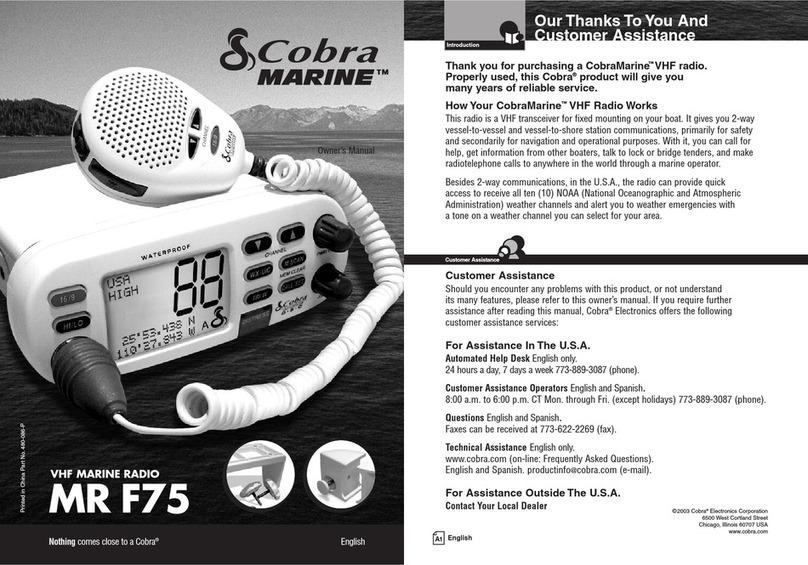
Cobra
Cobra MARINE MRF75 User manual
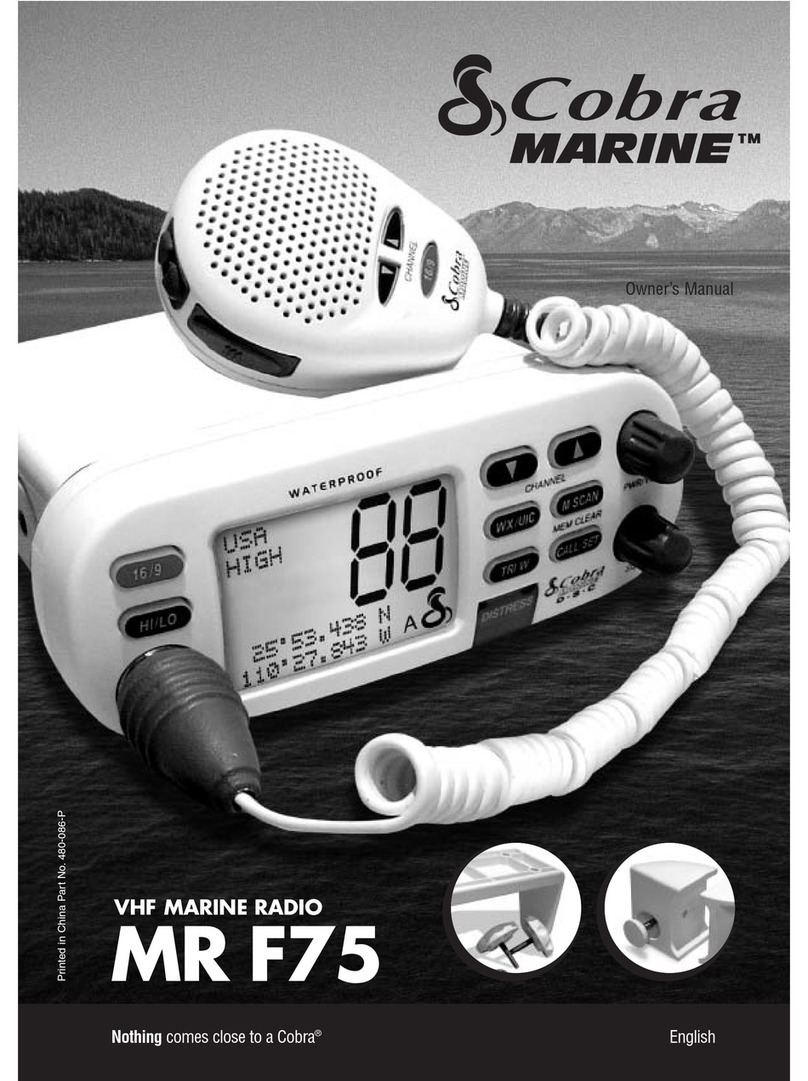
Cobra
Cobra Marine MR F75 User manual
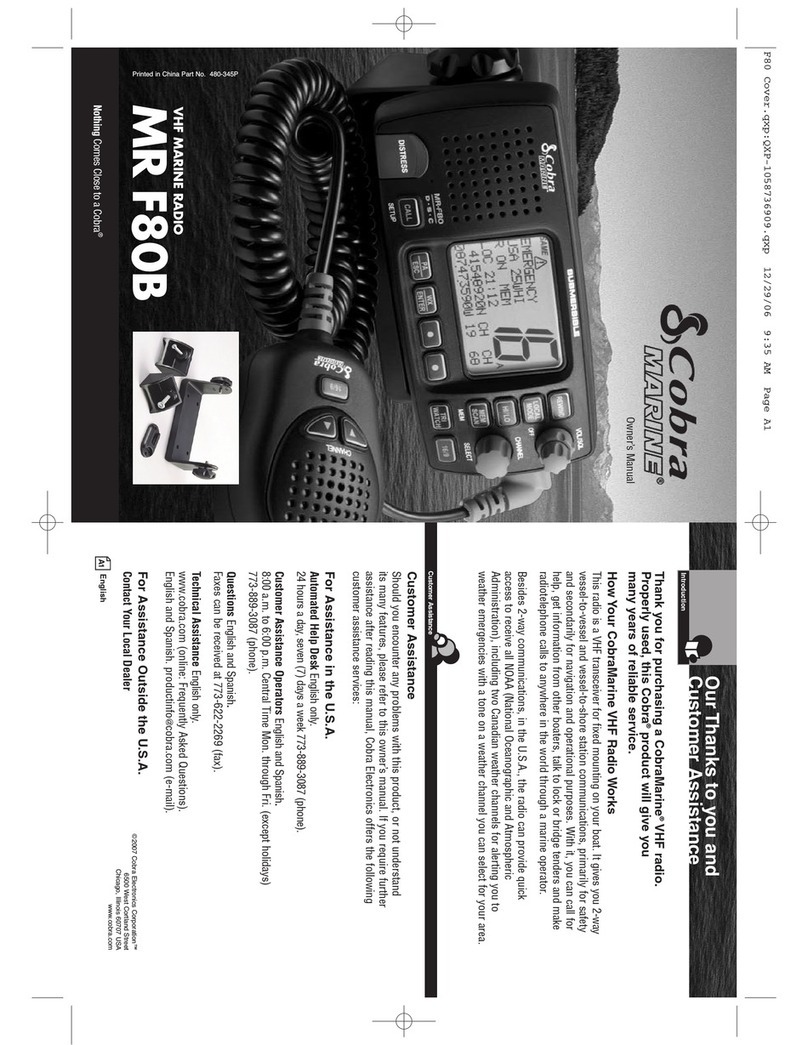
Cobra
Cobra MRF80B User manual
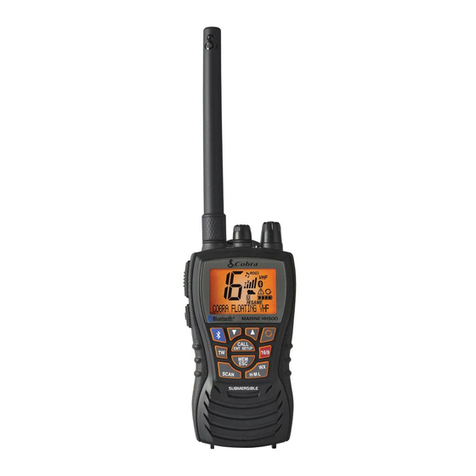
Cobra
Cobra MARINE HH500 User manual
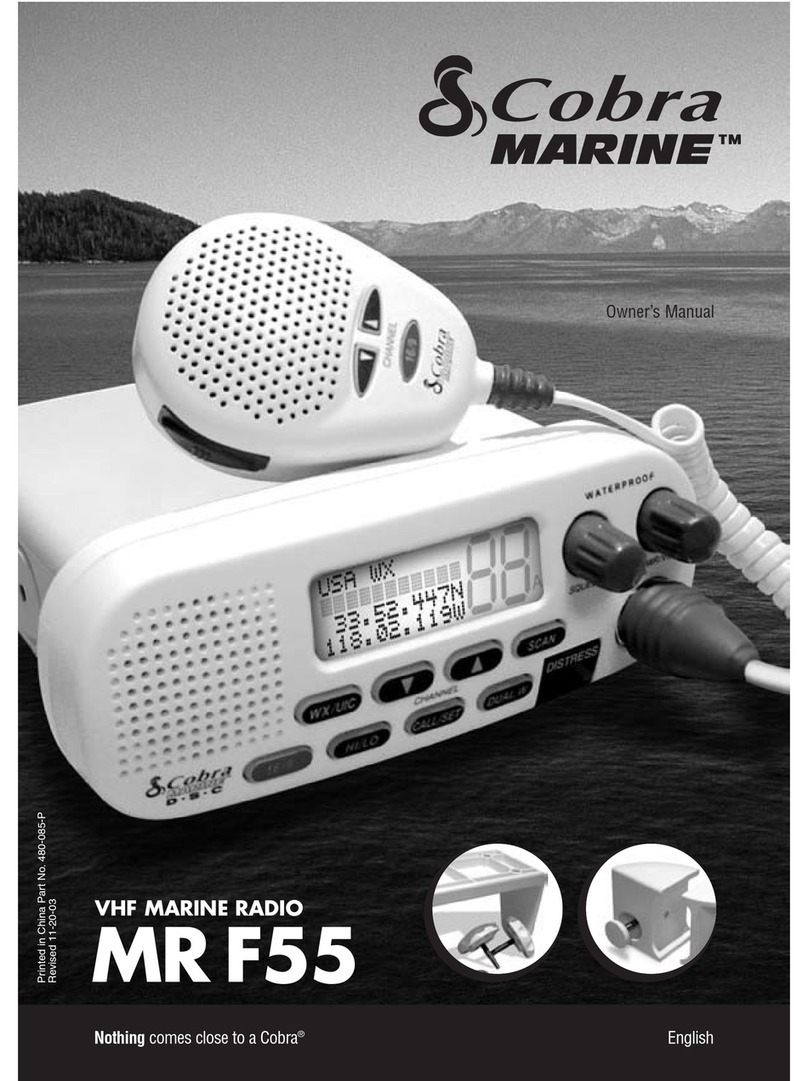
Cobra
Cobra MRF55 User manual
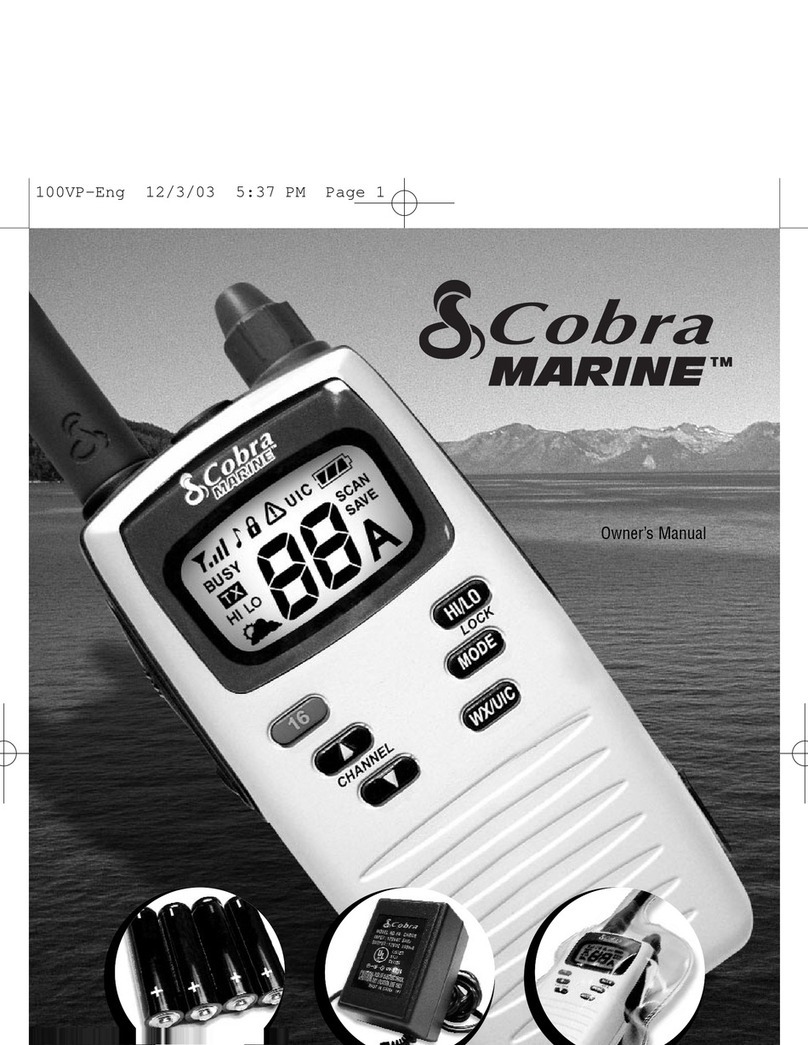
Cobra
Cobra MR HH100 VP EU User manual
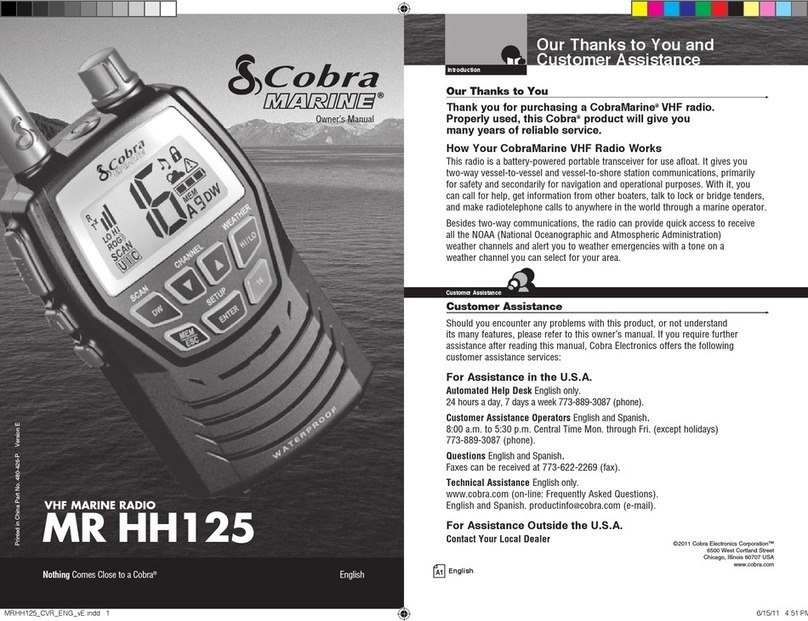
Cobra
Cobra Marine MR HH125 User manual
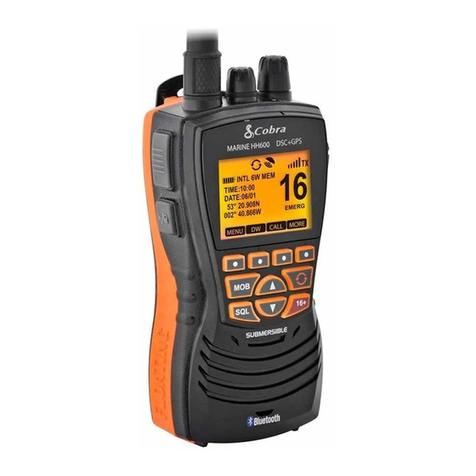
Cobra
Cobra Marine MR HH600 FLT GPS BT E User manual
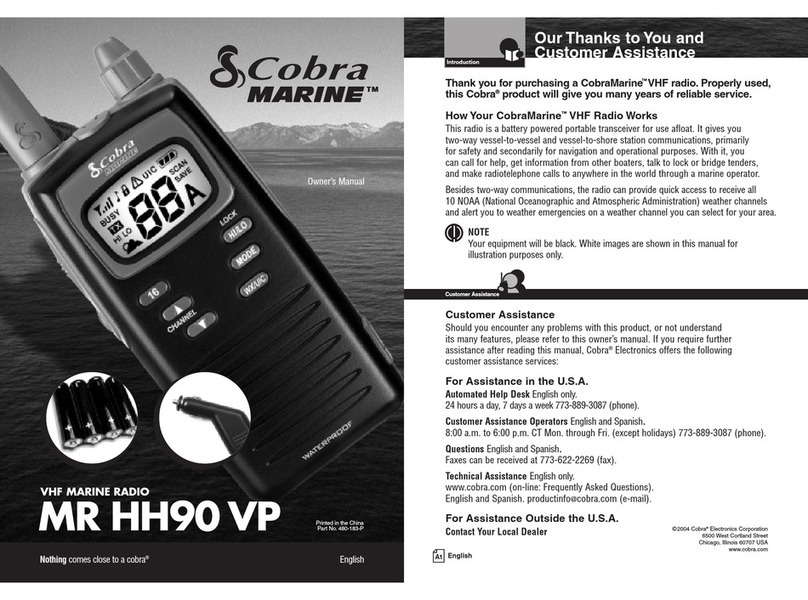
Cobra
Cobra MRHH90VP User manual
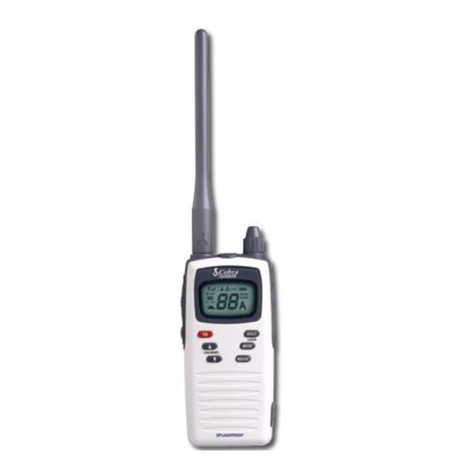
Cobra
Cobra MR HH100 VP EU User manual

